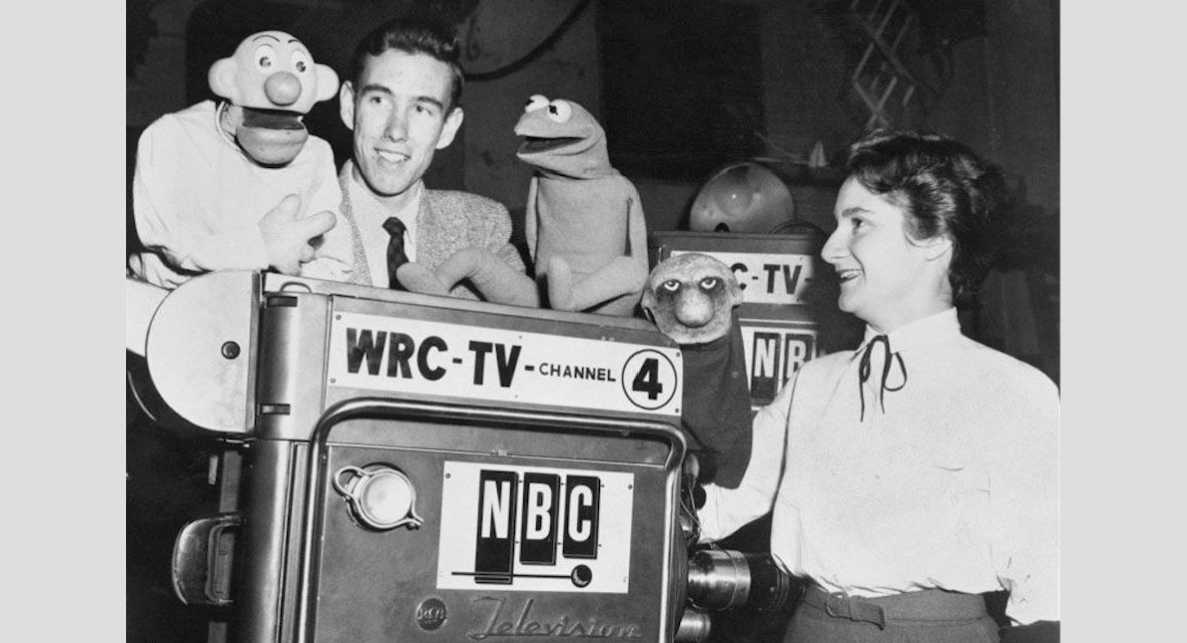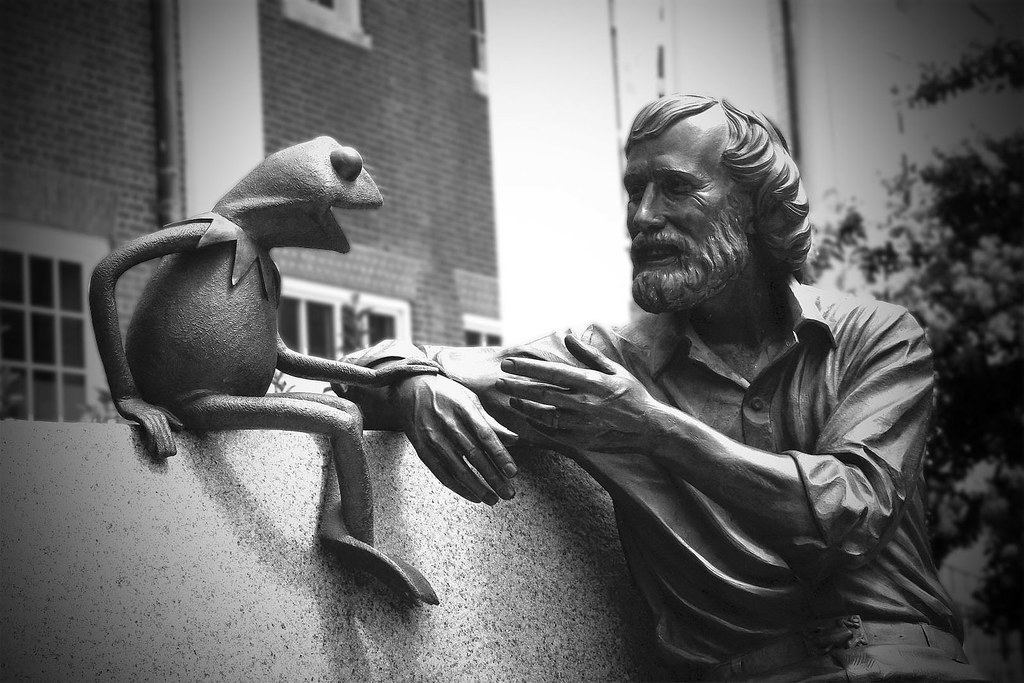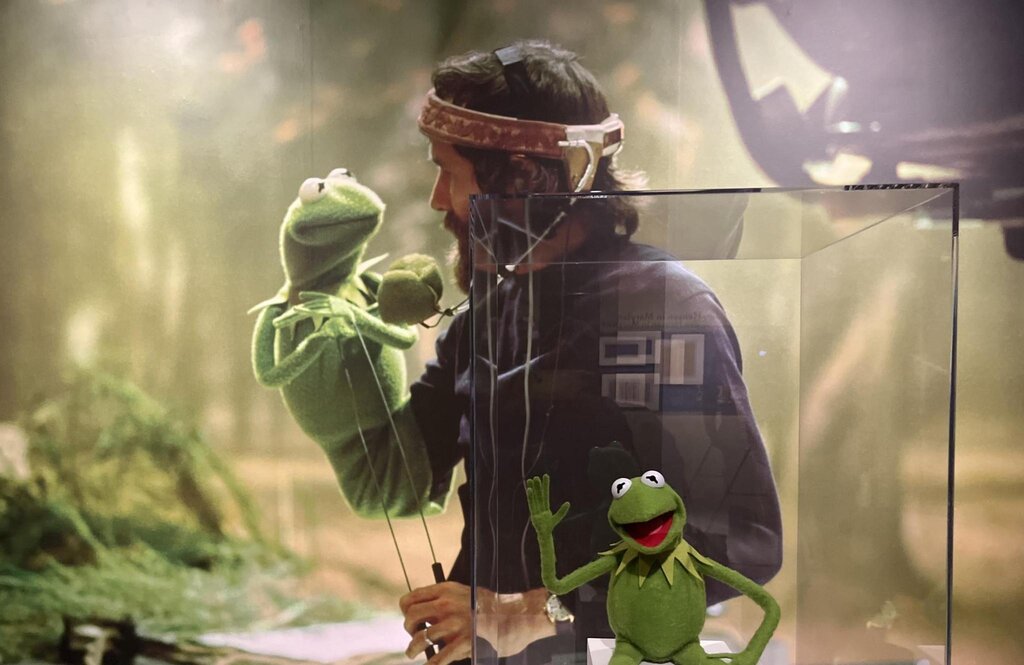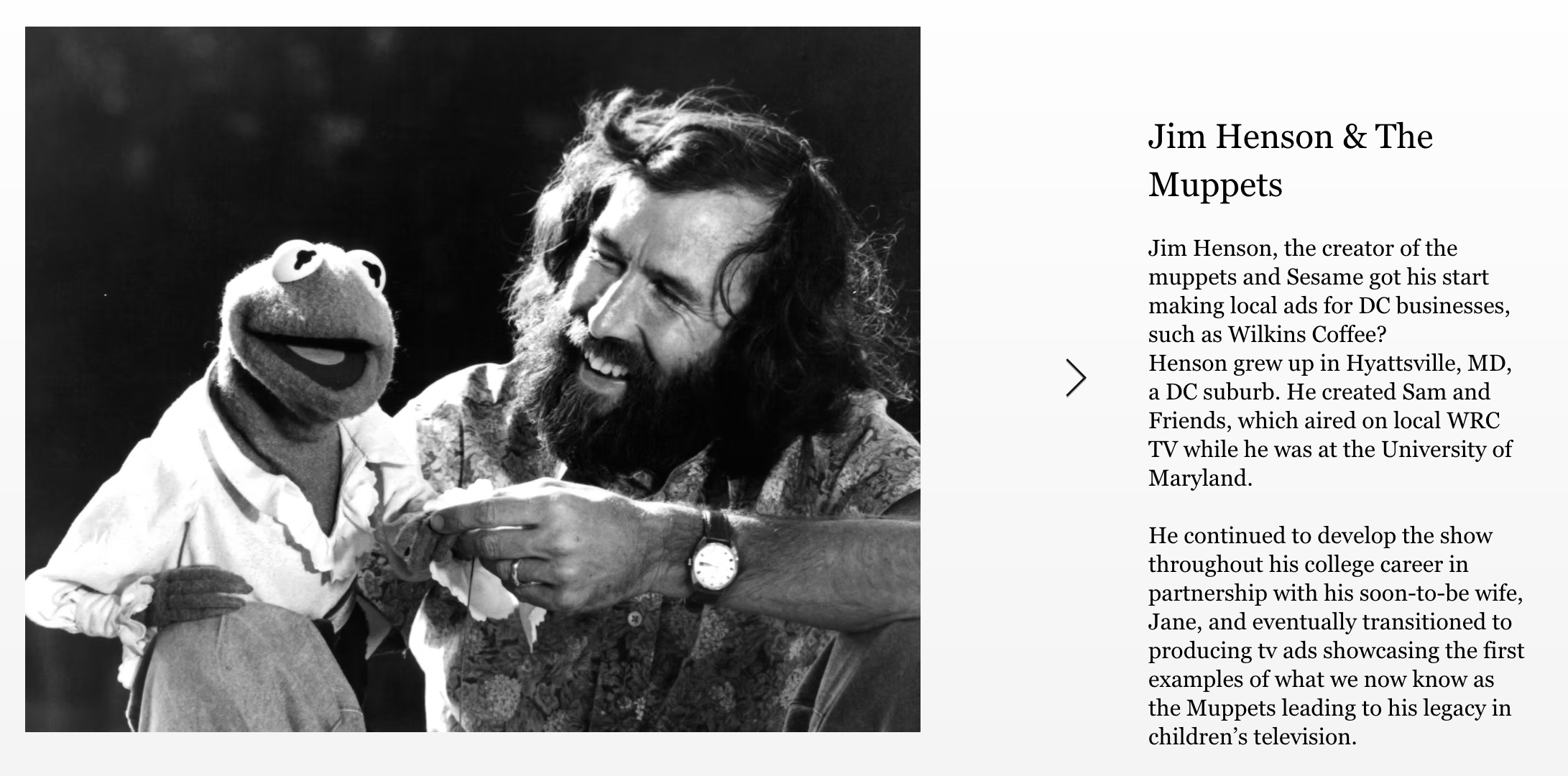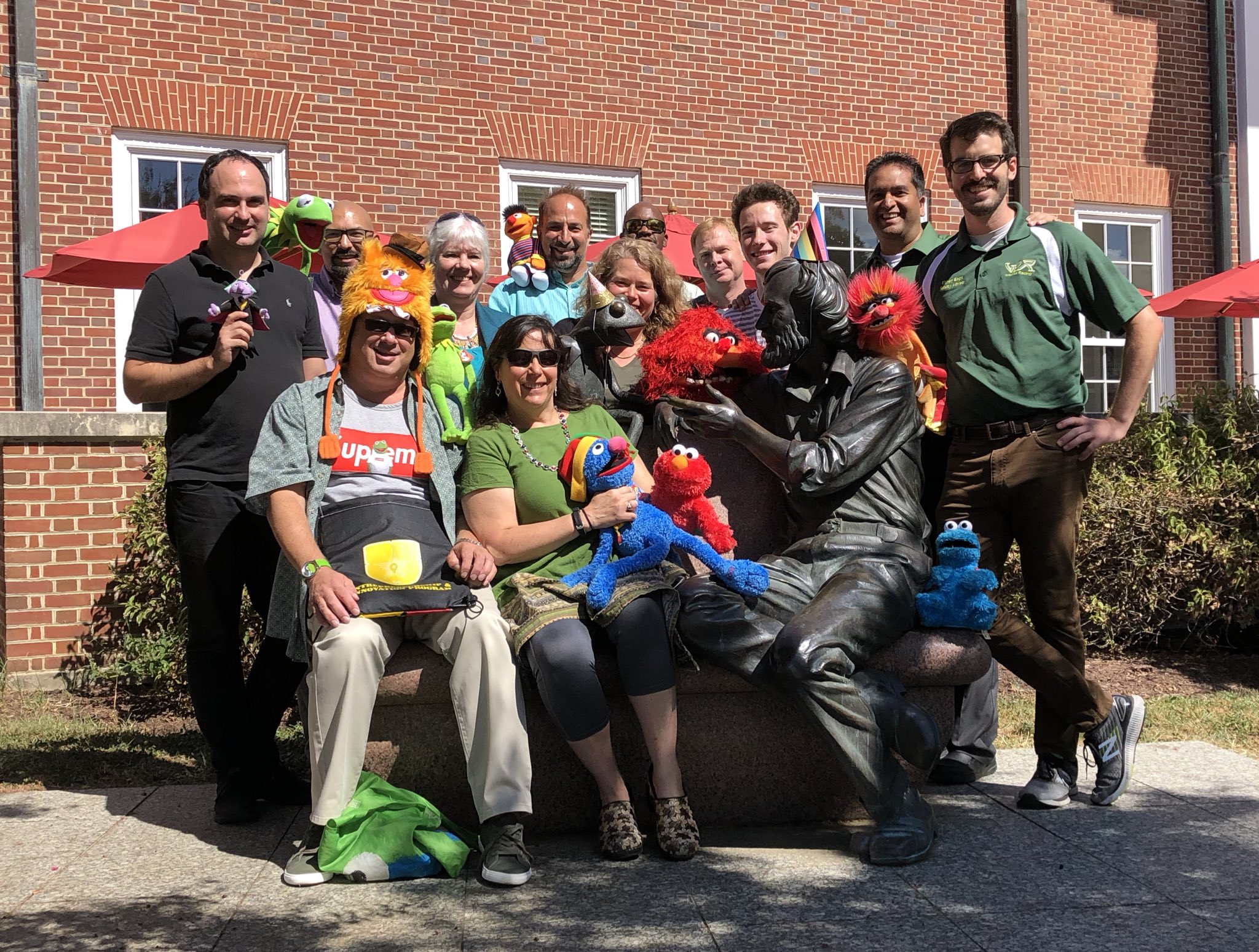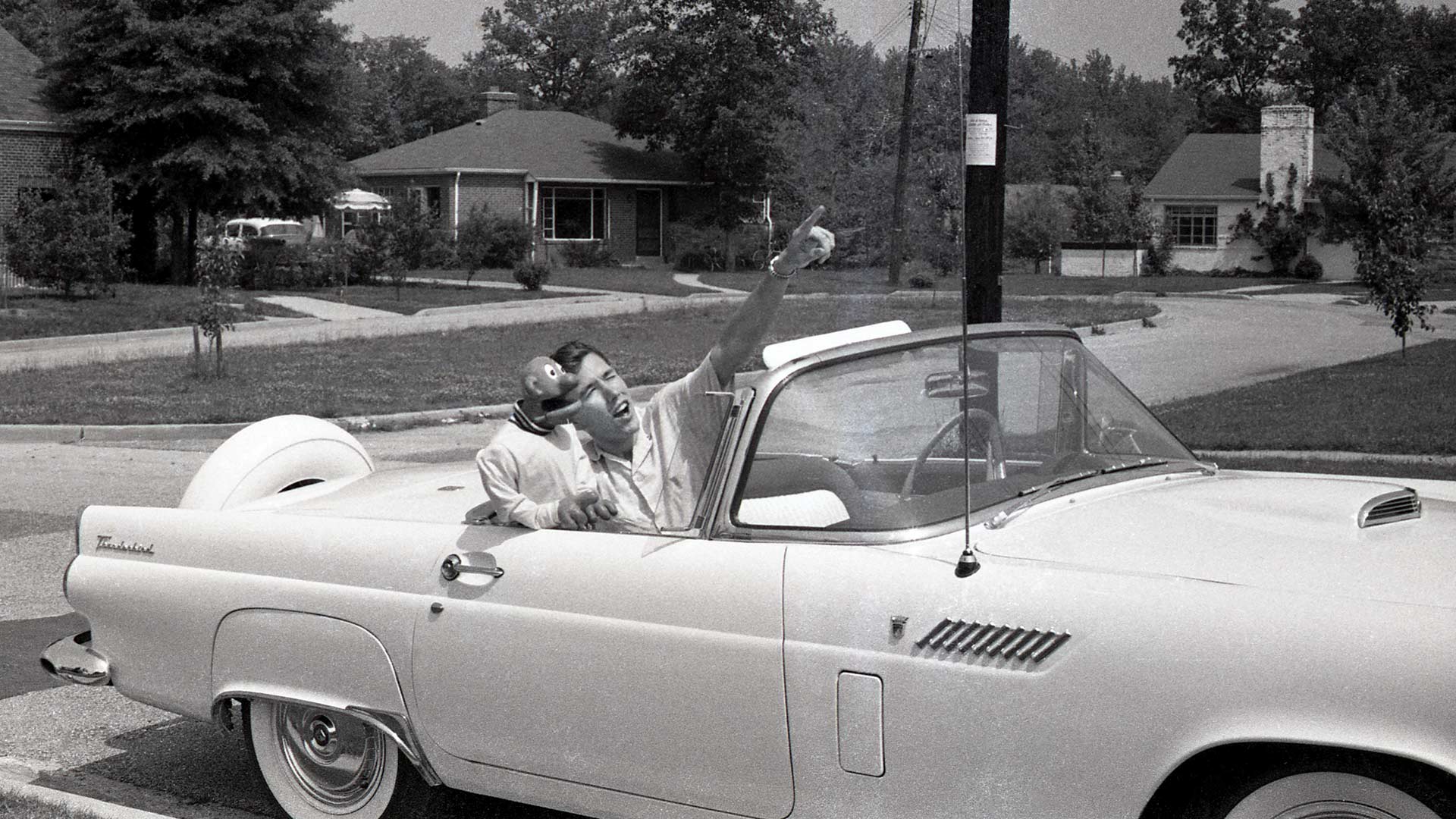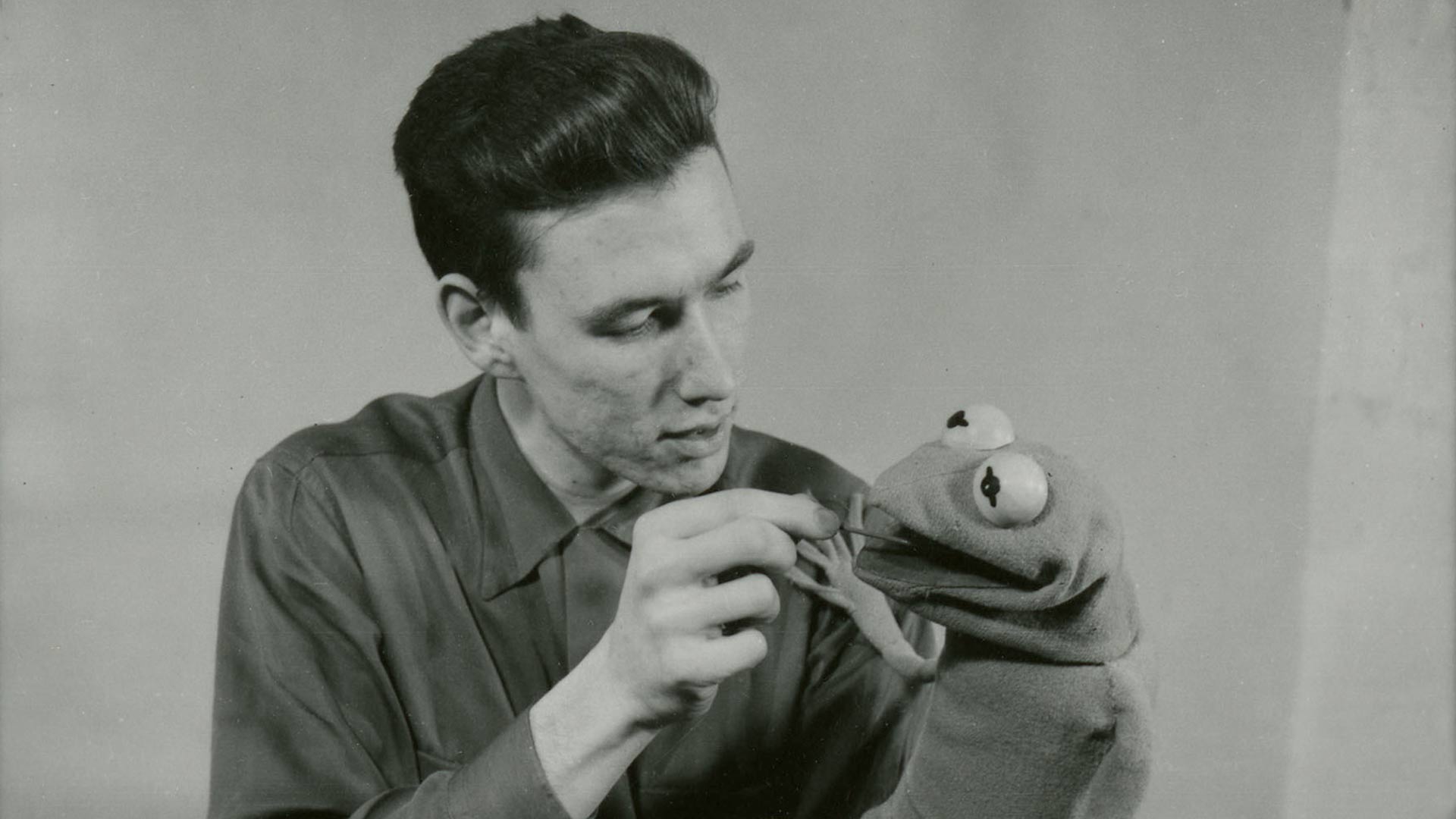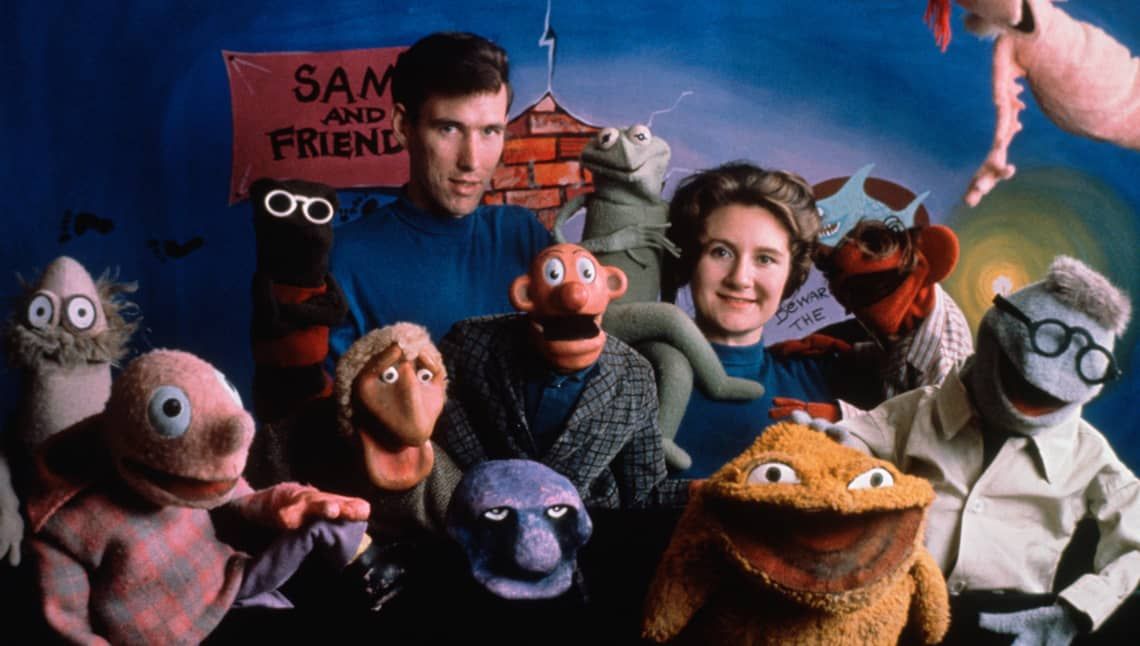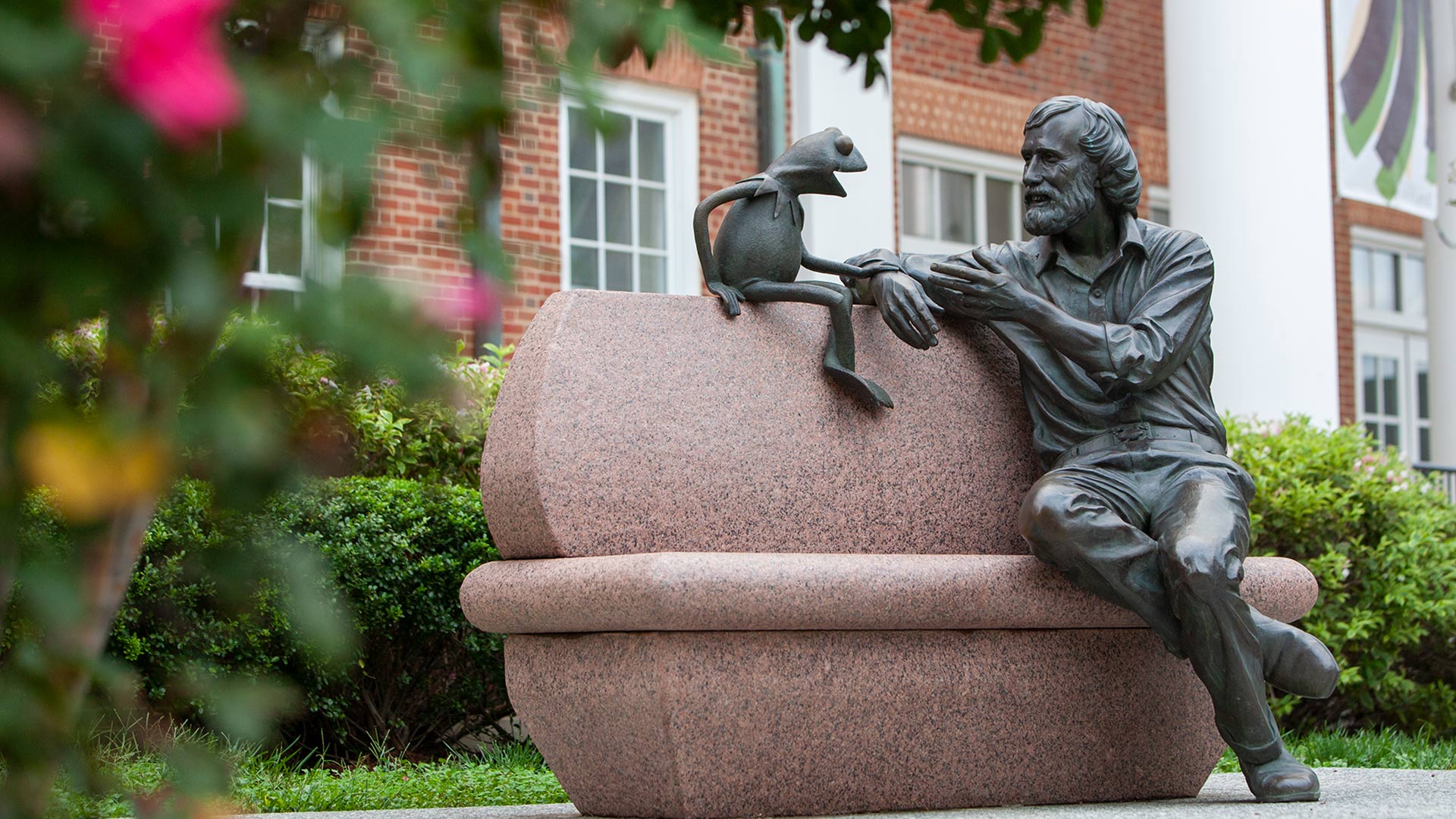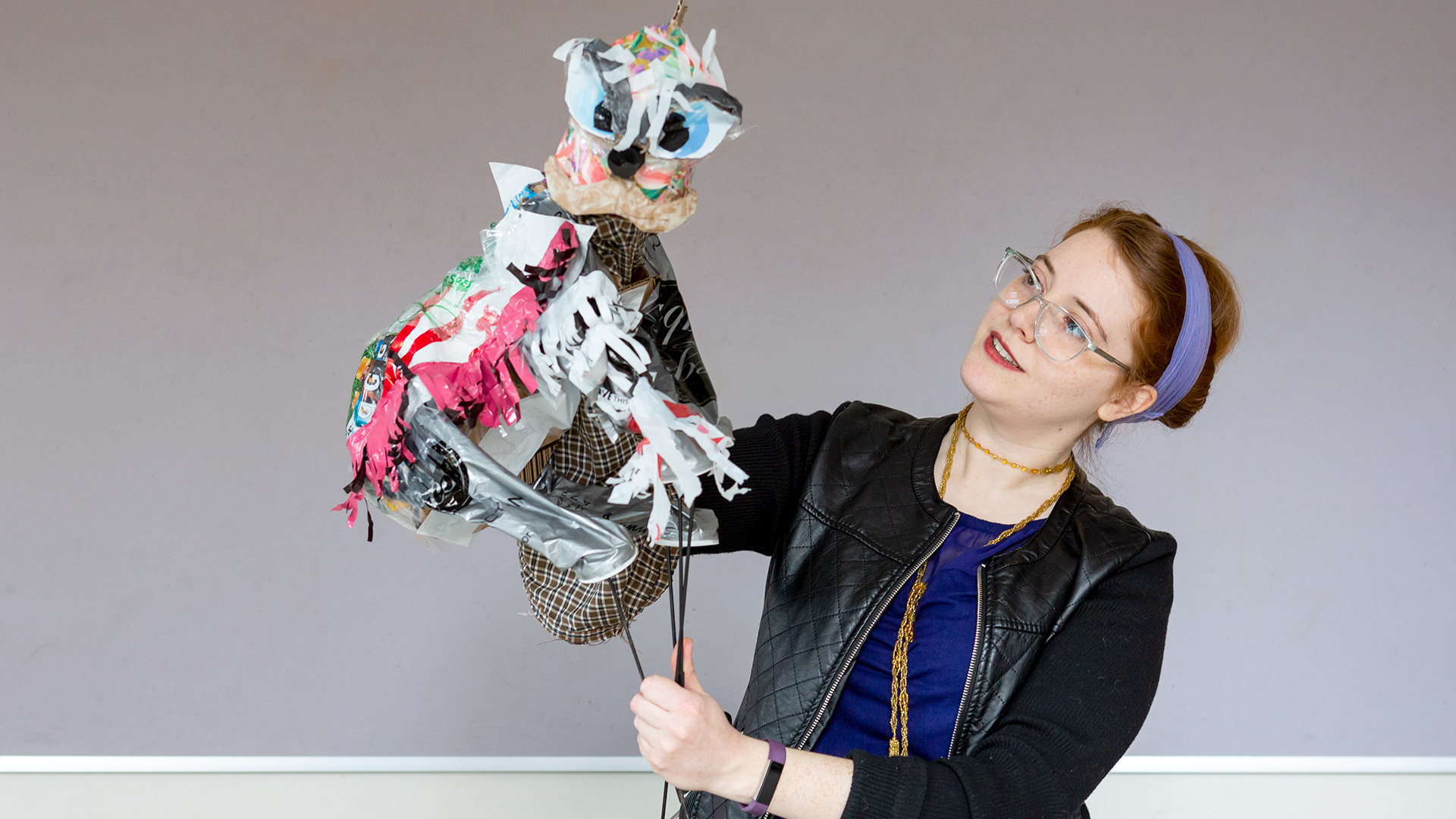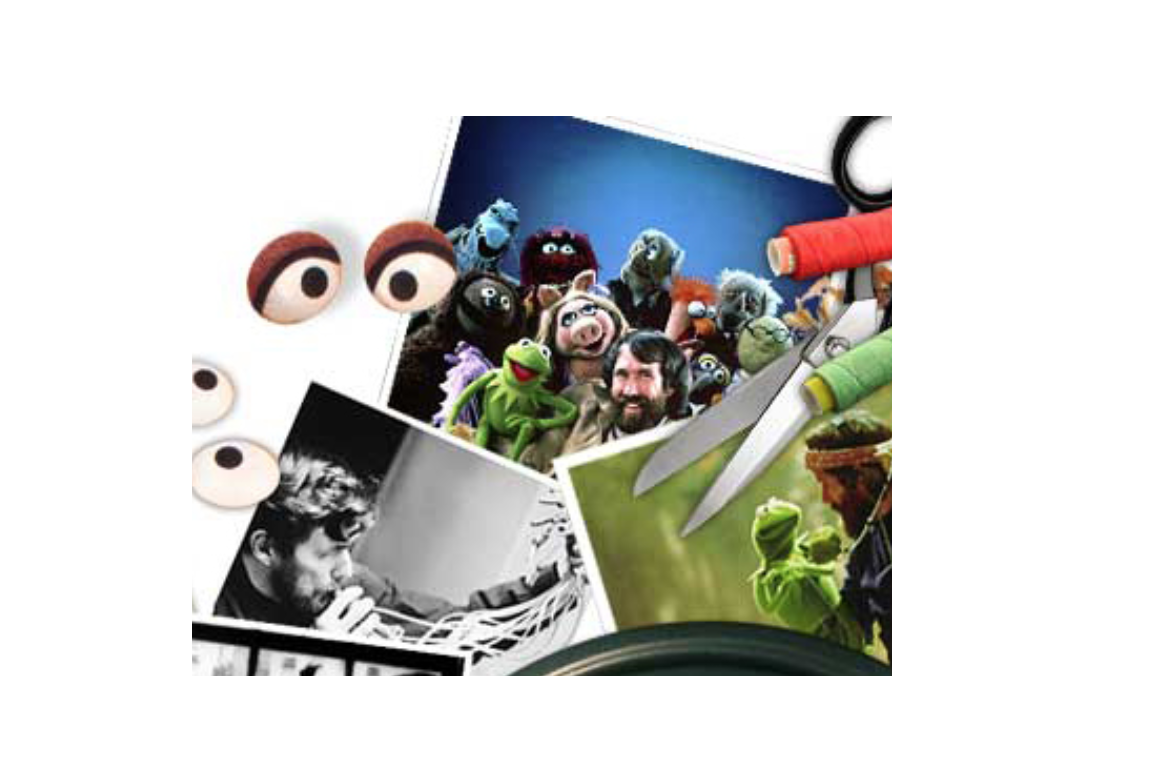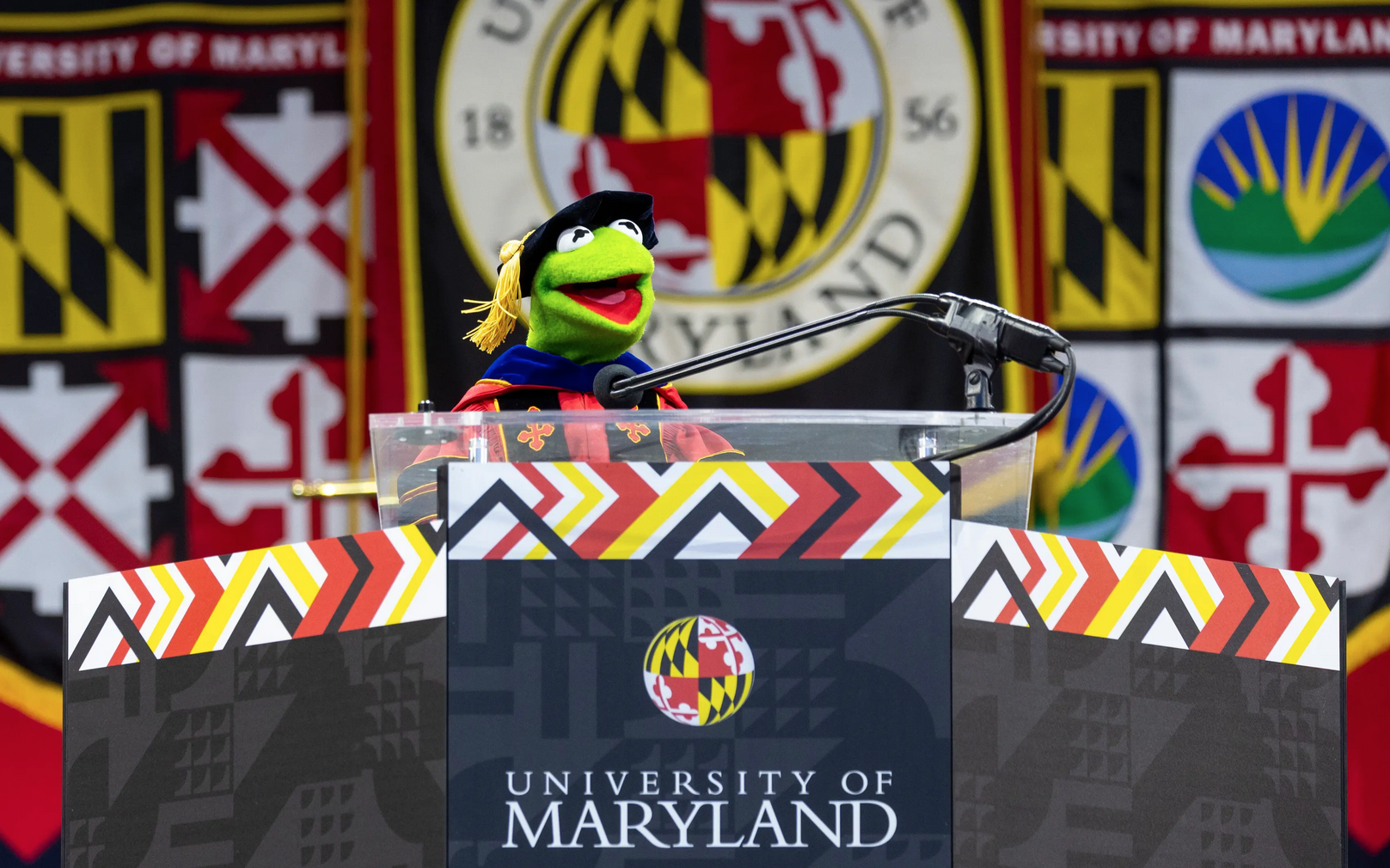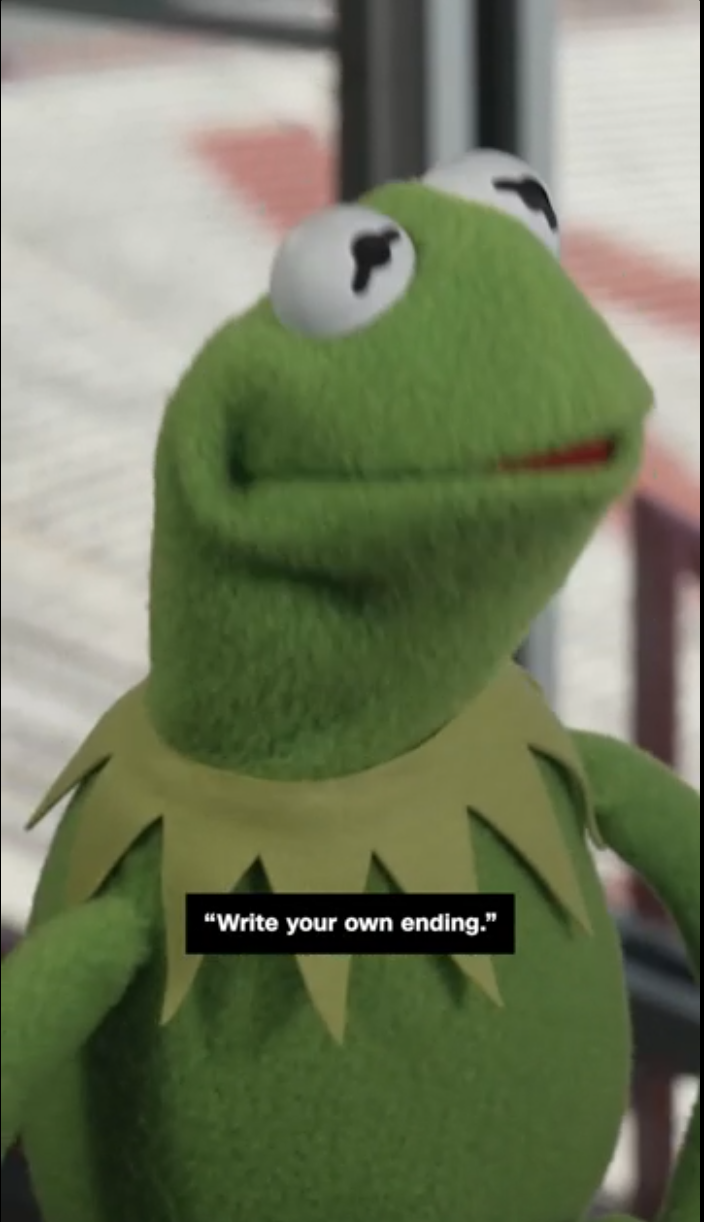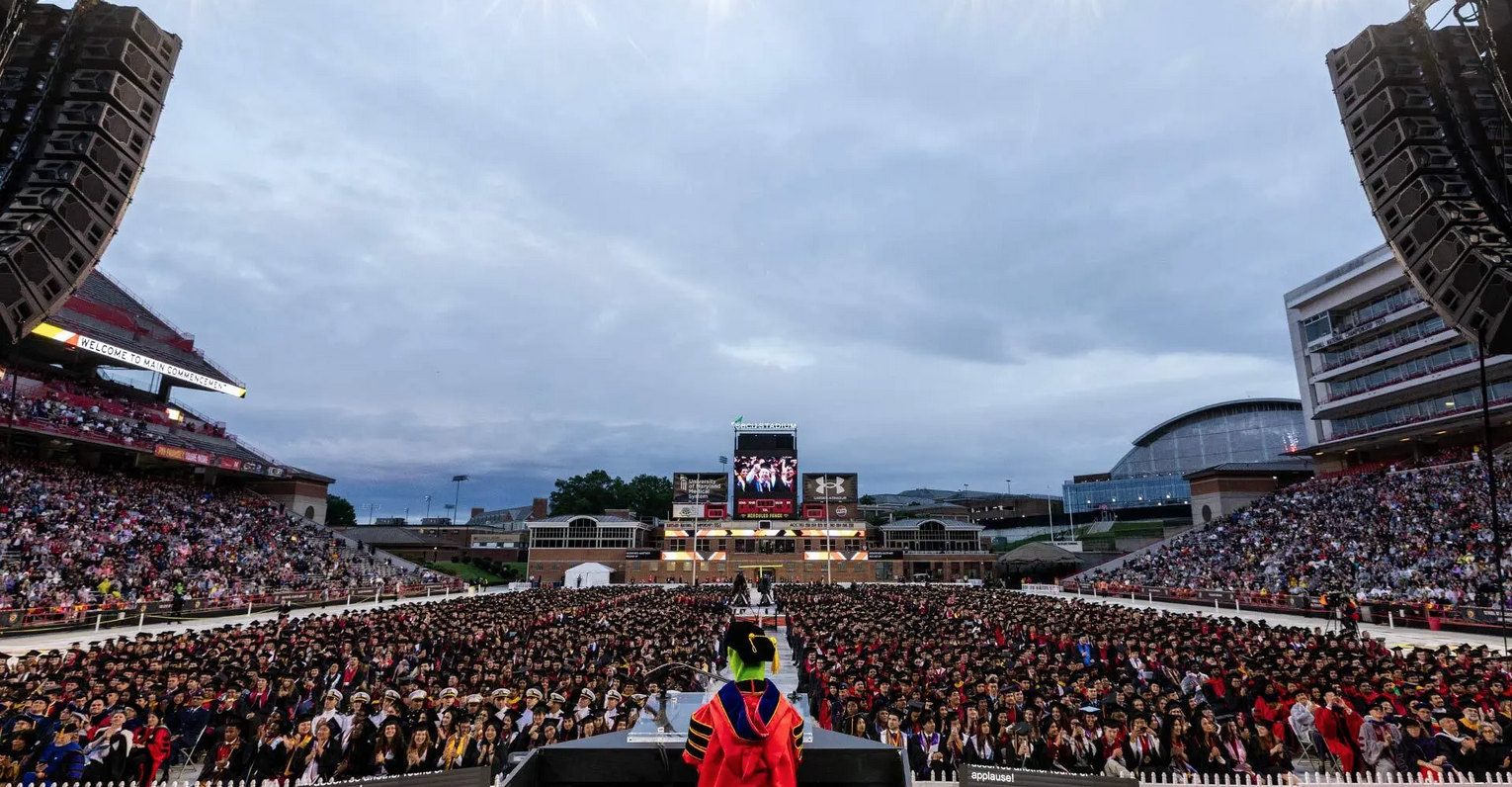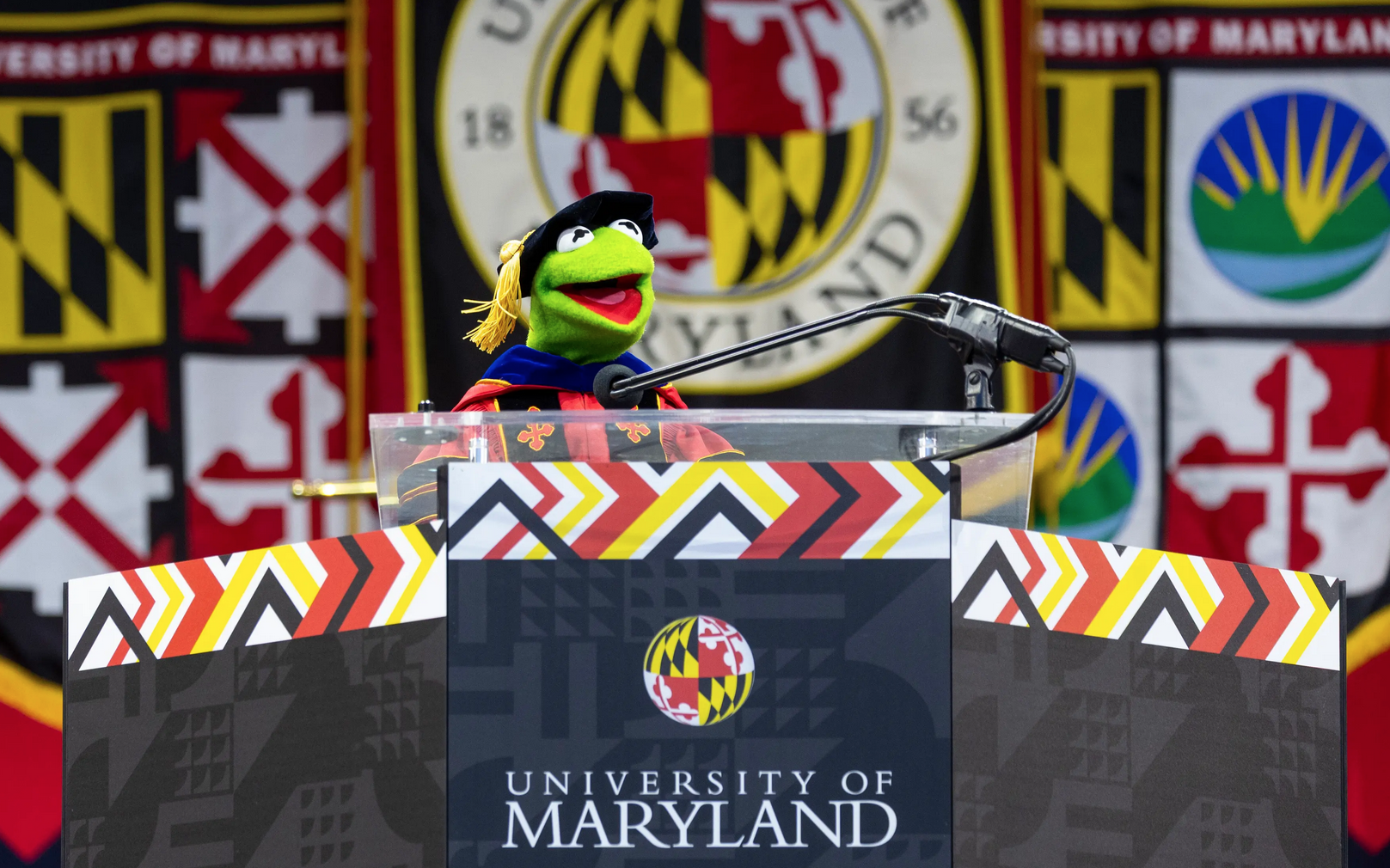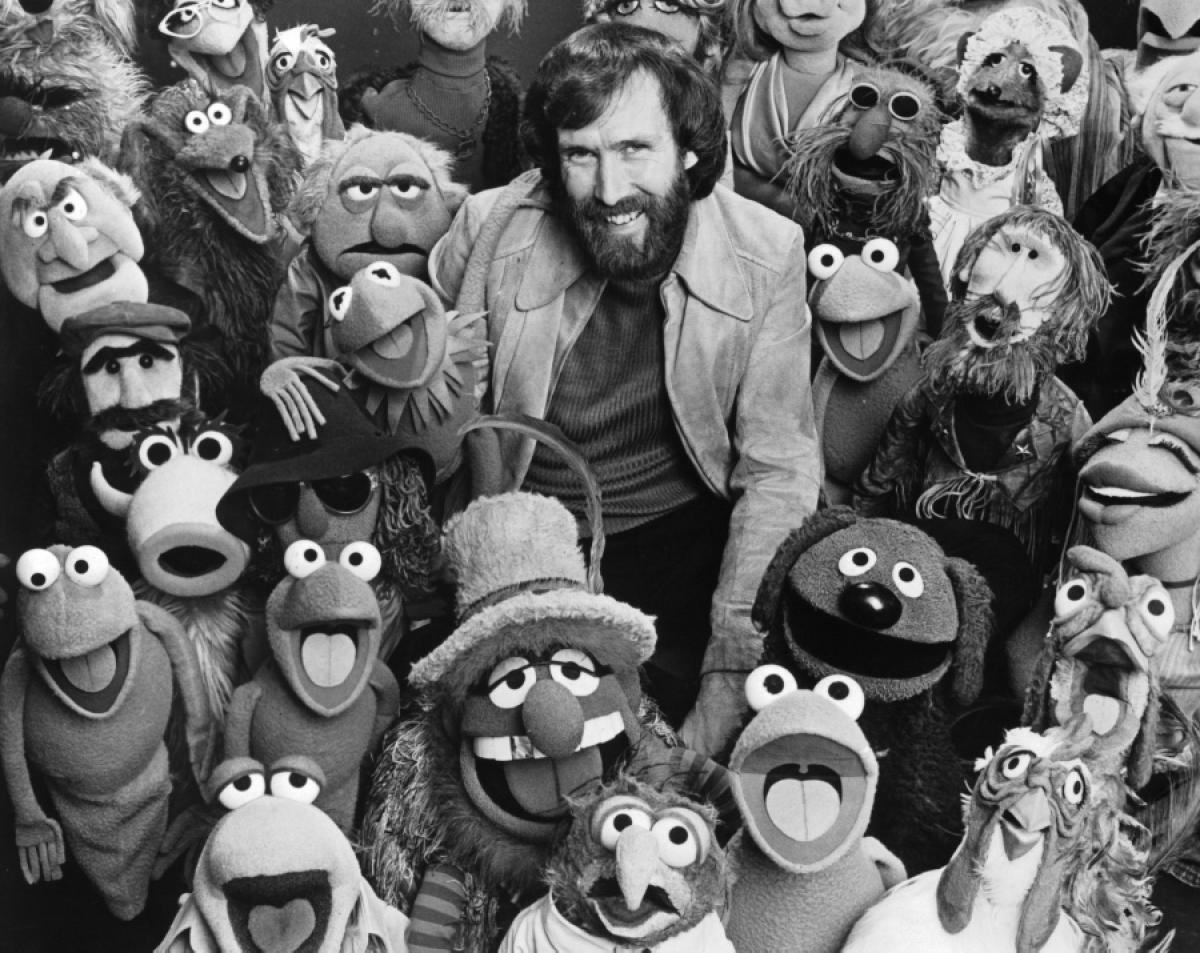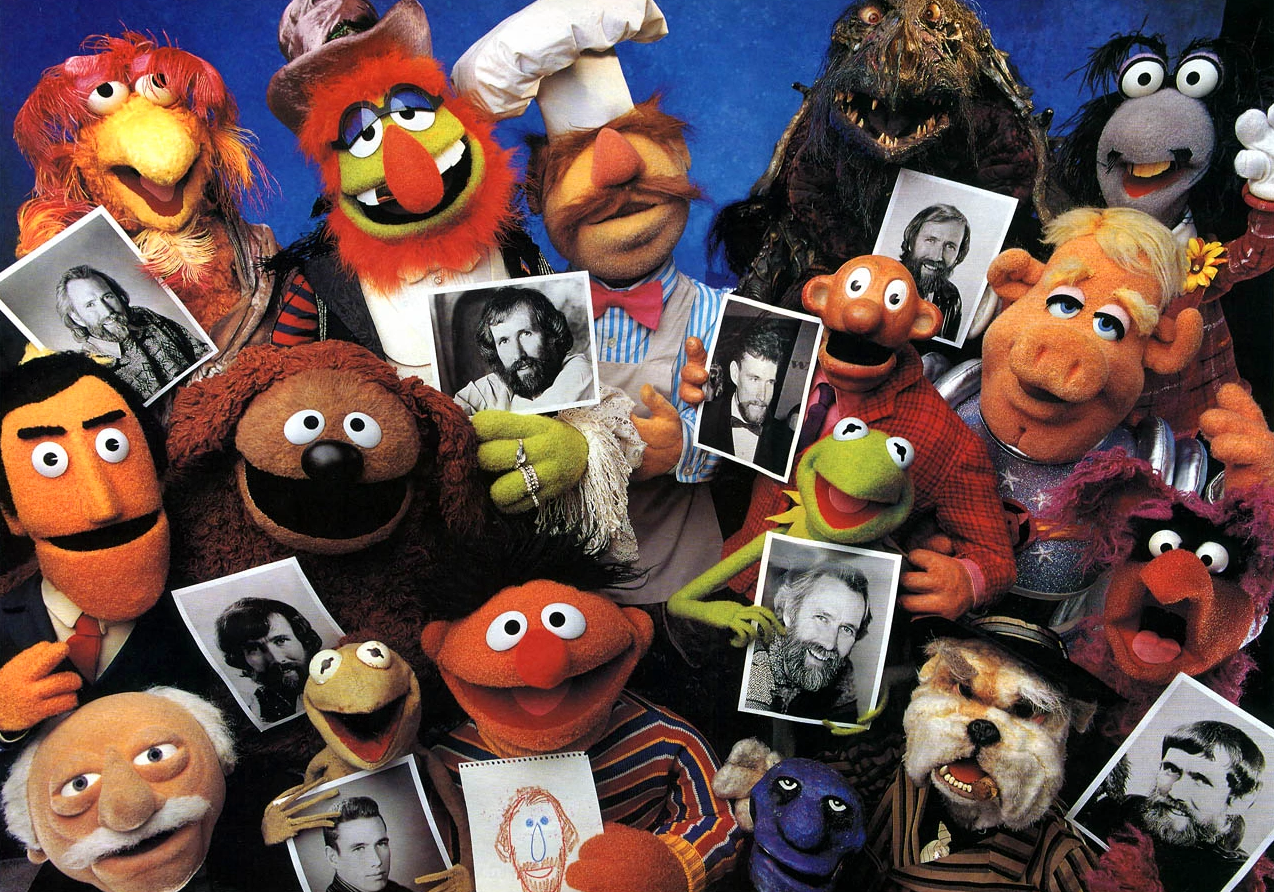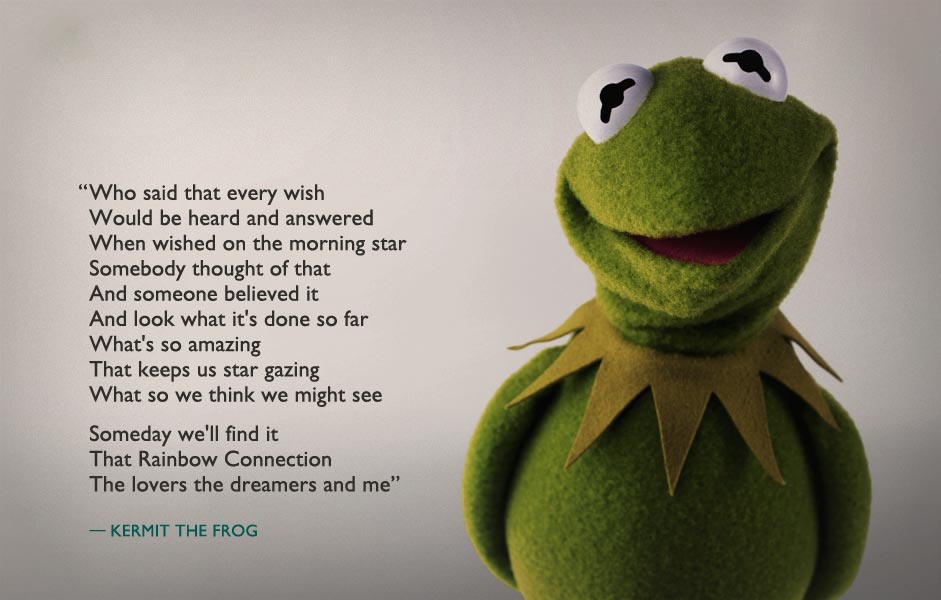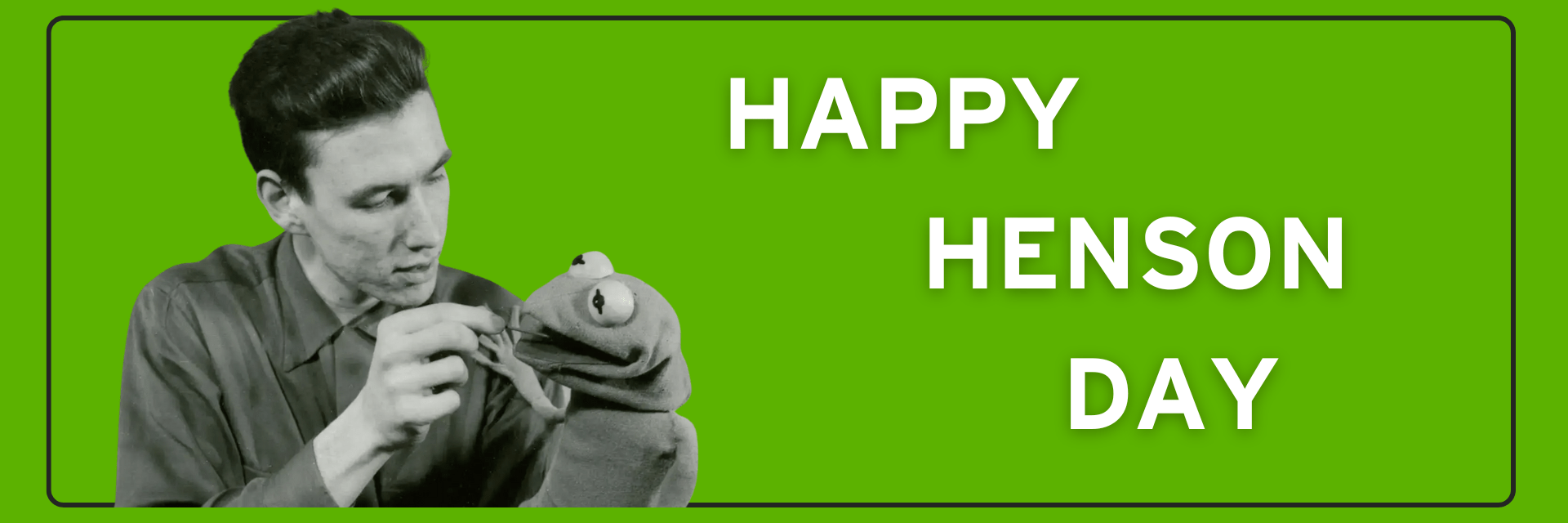
Henson Day
Happy Henson Day!
Every year on September 24th, the campus and surrounding communities celebrate the life, legacy, and works by University of Maryland alumnus, Jim Henson '60 & '78. Known for The Muppets, Sesame Street, The Dark Crystal, Fraggle Rock, and much more, Jim Henson laid the foundation for his future creations during his time as a student at UMD where he designed sets, programs, and posters for student theater productions. He also ran a silk screen printing business out of the Student Union, took a puppetry course where he met his first performing partner and future wife, Jane Nebel '55. Together, they developed and performed a daily five-minute show with puppets on local Washington, D.C. airwaves, WRC-TV, called Sam and Friends. The rest is history.
Jim Henson's imaginative storytelling of fantasy worlds combined with his mastery of and innovations in puppetry and media technology enabled him to creatively bring his Muppets to life. Generations of people all around the globe have been and continue to be inspired by Jim Henson's creations.
Share your appreciation of all-things-Henson every September 24th!
Be part of the fun on Henson Day or any day by spending some time unleashing your creativity and sharing your favorite Henson characters and stories on social media. When you post your gifs, images, and videos, don't forget to use the hashtags #HensonDay, #HappyHensonDay, and #TerpsHeartHenson.
This fun-filled tradition celebrates the life and legacy of Jim Henson and provides those who were and continue to be inspired by his creations an opportunity to share their appreciation on his birthday. Henson Day was established in 2018 by the UMD Henson Committee, which includes various campus and local community members, along with support from The Jim Henson Legacy.
To kick-off of this annual celebration, the UMD Office of Marketing and Communications published, "Five Things You Didn't Know About Jim Henson's Time as a Terp," in Maryland Today.
Here are a few ways you can join the fun on Henson Day:
- Academic Articles and Papers
- Educational Researcher: Children's Television Workshop
- JSTOR Daily: How Jim Henson Changed Early Education and Brought Puppets Back
- JSTOR Daily: Sesame Street’s Controversial Early Years
- JSTOR Daily: Why It Matters That Sesame Street’s Newest Resident Has Autism
- National Bureau of Economic Research: Early Childhood Education by MOOC: Lessons from Sesame Street
- Sociology of Education: The Impact of Sesame Street on Readiness
- TDR: A Puppet Tree: A Model for the Field of Puppet Theatre
- The Phi Delta Kappan: The Miracle on Sesame Street
- The Reading Teacher: Why Ernie Can't Read: "Sesame Street" and Literacy
- Articles
- Baltimore Magazine: Jim Henson Exhibit Celebrates Visionary Puppeteer’s Legacy—and Maryland Roots
- Boundary Stones: The Muppets Take Maryland
- Esquire: A Muppet Is Born Is the Star Is Born Remake We Deserve
- Film Cred: Jim Henson and the ABCs of Filmmaking
- Future of Information Alliance: “In essence, Sesame Street was the first MOOC” – Kearney and Levine
- KQED: A Deeper Look at Jim Henson, the Man Behind the Muppets, and His Unbridled Innovations
- Maryland Today: A Puppet by Any Other Name
- Mental Floss: 31 Genius Facts About Jim Henson
- Mental Floss: Remembering Jim Henson
- The Credits: “Jim Henson: Idea Man” Editors On Making a Documentary the Muppets Creator Would Have Made Himself
- The New Yorker: How We Got to Sesame Street
- Blogs
- Commercials
- Documentaries/Films/Movies
- History & Imagery from the Smithsonian
- 37c Jim Henson single stamp
- Bert Puppet
- Chicken Liver Puppet from Sam and Friends
- Cookie Monster Puppet
- Count von Count Puppet
- Elmo Puppet
- Ernie Puppet
- Fozzie Bear Puppet
- Grover Puppet
- Harry the Hipster Puppet from Sam and Friends
- Jim Henson photograph
- Kermit the Frog Puppet
- Miss Piggy Puppet
- Original Kermit Puppet
- "Pigs in Space" Puppet
- Prairie Dawn Puppet
- Red Fraggle Puppet
- Rosita puppet used on Sesame Street
- Rowlf the Dog Puppet
- Sam Puppet from Sam and Friends
- Scooter Puppet
- The Muppets Lunchbox
- The Swedish Chef Puppet
- Wilkins Puppet
- Music
- Podcasts
- KQED: Gonzo the Great on the Creativity and Collaboration Behind Jim Henson’s Muppets
- Lost at the Smithsonian with Aasif Mandvi: The Original Muppets
- Muppet Fan Podcast with ToughPigs
- Muppet Hub: The Archives
- Muppeturgy
- Smithsonian: The 'Gentle Anarchy' of the Muppets
- Studio 360: It’s Not Easy Being Evergreen: An Oral History of the Muppets
- Stuff You Should Know: How Jim Henson Worked
- Stuff You Should Know: How Muppets Work
- Sweet & Condensed: Jim Henson, The Muppets, and the Power of Puppetry w/ Special Guest Amerique Monagle #61
- The 'Gentle Anarchy' of the Muppets
- The Muppet History Podcast
- The Muppet Show Podcast
- Puppetry
- Television
- Videos
- 107 Muppets Facts You Should Know! | Cinematica
- Early Childhood Education by MOOC: Lessons from Sesame Street
- How Henson Puppeteers Bring Puppets to Life
- Jim Henson
- Jim Henson and Kermit the Frog on Can We Talk? with Joan Rivers
- Jim Henson and The Muppets Visit The Tonight Show Starring Johnny Carson - 03/18/1975
- Jim Henson, Kermit, and Rowlf on The Arsenio Hall Show (1989)
- Jim Henson Legacy
- Late Night Muppets - The Land of Gorch: Saturday Night Live's Ill Fated Muppet Show
- Muppets take MSNBC! See icon Ron Howard on Jim Henson & Sesame St. in Melber ‘Summit Series’
- Sesame Street Puppeteers Explain How They Control Their Puppets
- The Engineering Behind the Muppets
- The Evolution of 10 Classic Muppets
- The Muppets' Cancelled Movies: A Henson History
- The Song that Gave Kermit His Soul
- The World of Jim Henson
- Wiki
- Exhibits
- Atlanta, Georgia - Center for Puppetry Arts: World's of Puppetry
- Baltimore, Maryland - The Maryland Center for History and Culture. From May 26th - December 30th, 2023: The Jim Henson Exhibition: Imagination Unlimited
- Queens, New York - Museum of the Moving Image: Imagination Unlimited
- Washington, D.C. - National Museum of American History: Miss Piggy Joins Kermit the Frog at the Smithsonian
- Dearborn, Michigan - The Henry Ford: Celebrating Jim Henson and His Legacy
- Plaques
- School
- Trail
- 51 Steps to Freedom - Take this trail to unravel the mystery of why DC is the hub of American history and culture, and how it continues to redefine America as a beacon of liberty and opportunity. This trail fosters a deeper understanding of America’s shared history. Included in the trail is Jim Henson.
Jim Henson as a University of Maryland Student
In 1954, Jim Henson entered the University of Maryland, College Park as a major in studio art. The multitude of artwork that survives from this point in Jim’s career indicates that he had a colorful visual imagination, a sharp eye for detail, and a creative knack for design.
As a freshman at the University of Maryland, Jim was given the opportunity hone his puppetry skills during a course in the Home Economics Department, as well as through practical experience. His earliest endeavors into television took place immediately before and during his time as an undergraduate at UMD. While a student in a puppetry class, he met fellow University of Maryland student Jane Nebel, who was an early partner in his television shows and would later become his wife.
Following a short-lived morning puppet segment on a local Washington station, Jim was hired by WRC-TV in 1955 to create a five-minute puppet show that would air twice nightly. Entitled Sam and Friends, this program earned Henson his first Emmy in 1958 – two years before his graduation from the University of Maryland. For Sam and Friends, Henson introduced many of the elements that would become mainstays of his Muppet Show aesthetic – music, zany humor, and an early Kermit as a lizard-like creature. During his time at Maryland and WRC-TV, Jim Henson began to develop innovative puppetry skills that made his Muppets life-like and expressive, and that would have a profound effect on the way puppetry would be performed for television and films.
Jim Henson's Legacy at the University of Maryland
Throughout his career, Jim's connection to the University of Maryland remained strong. He was awarded an Honorary Doctor of Fine Arts degree and was the recipient of the Distinguished Alumnus Award of Distinction serving as the Grand Marshall at the University's Homecoming parade. Jim was also active with the University of Maryland Foundation and Kermit the Frog served as the spokesfrog. After Jim's passing in 1990, the UMD Marching Band honored Jim and Jane with a Homecoming tribute.
On September 24th, 2003, this bronze statue of Jim Henson and Kermit the Frog sitting on a red granite bench and weighs 450 pounds was unveiled in a joyous gathering of family, friends, and members of the campus community. It was created by sculptor Jay Hall Carpenter who was awarded the commission after an extensive design competition led by Jane Henson. The statue is surrounded by a memorial garden, designed by landscape architect Philip Cho. The landscaped garden provides a welcoming setting to enjoy Jim Henson's creativity, humor, and positive vision. The entire project cost $217,000 and was funded in part by gifts from the Classes of 1994, 1998, and 1999.
You can read more about the creation of the statue and the Jim Henson Memorial Garden at the University of Maryland at the Muppet Wiki.
To honor the legacy and creative genius of University of Maryland alumnus Jim Henson ‘60, alumna Jane Henson ‘55 established the Jim Henson Artist-in-Residence Program in 2006. The generosity of the Henson family has allowed the school to bring internationally acclaimed puppet artists to campus for a semester-long residency to teach courses, conduct workshops, create puppets for main season productions and mentor student artists with independent study projects.
Recent artists include:
- Blair Thomas
- Ralph Lee and the Mettawee River Theatre Company
- Chinese Theatre Works’ Kuang-Yu Fong and Stephen Kaplin
- Basil Twist
- Zvi Sahar and Leslie Strongwater of PuppetCinema
- Aaron Cromie
- Alex Vernon
- Robin Forhardt
- Kevin Augustine
In 2002, Jane Henson established The Henson Endowment for Performing Arts which supports Clarice Smith Performing Arts Center programs related to puppetry.
In 1996, Jane Henson established The Jim Henson Fund for Puppetry to foster interest in and encourage student work in the art of puppetry. The School of Theatre, Dance and Performance Studies hosts an annual competition and recipients are awarded funds to create a puppet project or performance. Every year the talented student recipients perform/present their funded projects during the Henson Awards Showcase.
Read more about the a few of The Jim Henson Fund for Puppetry recipients below.
Jim Henson awards showcase brings student puppeteers to the main stage
- By Chris Barylick
For The Diamondback - April 3, 2023
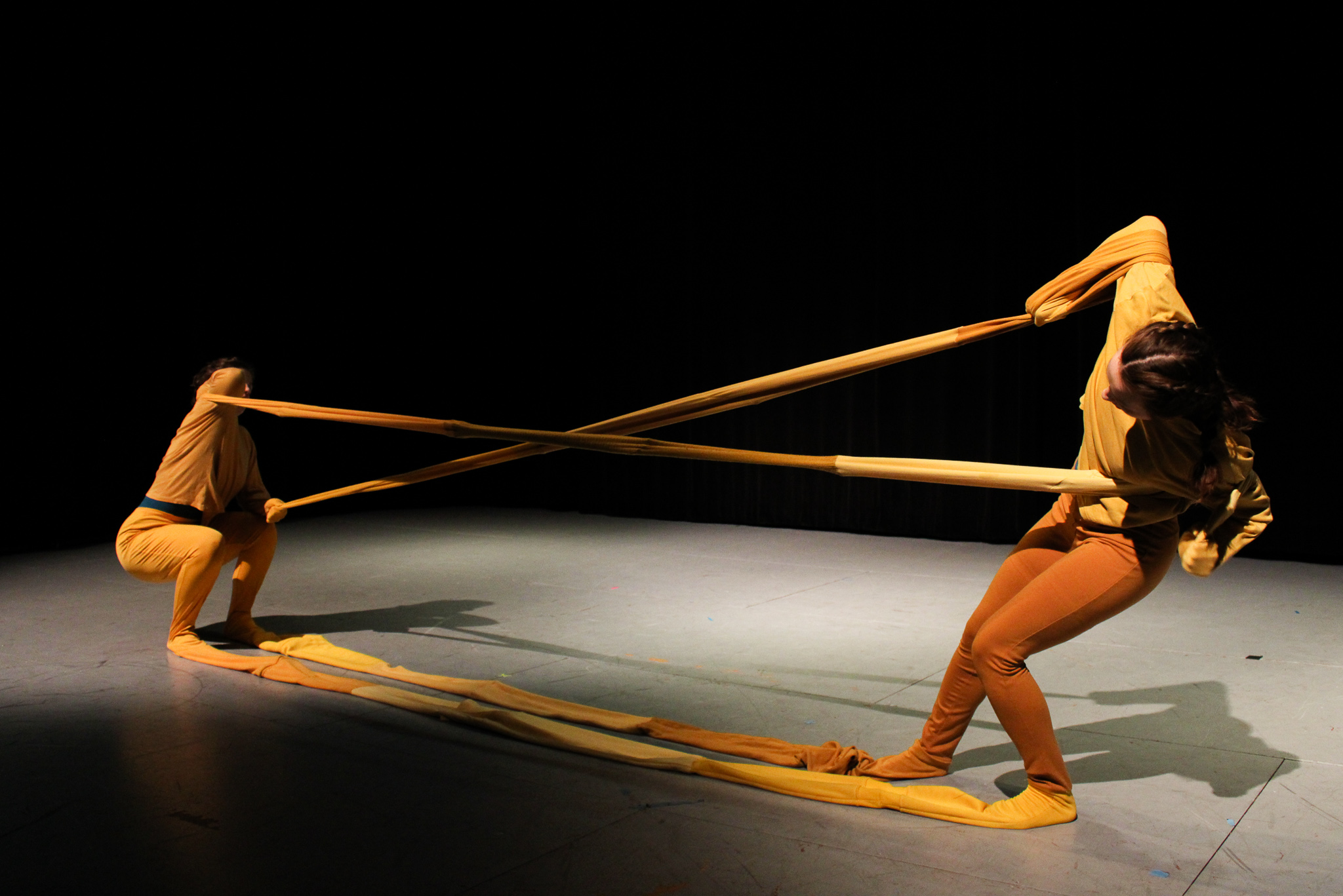
Students preform "STUMBLE MERGE," a puppetry-focused original one-act, on March 30, 2023. This project was exhibited during the 2023 Henson Awards Showcase, a collection of performances hosted by the theatre, dance and performance studies school at the University of Maryland, that present student projects funded by the Jim Henson Fund for Puppetry. (Giuseppe LoPiccolo/The Diamondback)
It was a surreal series of performances at the Cafritz Foundation Theater in The Clarice Smith Performing Arts Center for the Henson Awards Showcase 2023 Thursday night. In a packed house, five award recipients presented their puppetry pieces and explained the meaning behind them.
The showcase, which was inspired by University of Maryland alum and Muppets creator Jim Henson and collaborator Jane Henson, awards recipients get $1,500 to write, build and perform a piece.
This year’s selections went to Mary Kathryn Ford, a graduate dance major, Charlotte Rachel Richardson-Deppe, a graduate studio art major, Leo Grierson, a graduate theatre design major, Daniel Miramontes, a graduate dance major and Miele Murray, a freshman theatre major.
“I’m really glad we got this award,” Richardson-Deppe said. “It’s been wonderful to be supported. I think as someone who moves between performance and art, this is like a perfect joining of performance and art where I can totally bring soft sculpture and MK [Mary Kathryn Ford] can bring all their dance background. And we can jam.”
The show began with master puppeteer Dr. I Nyoman Sedana, who presented an Indonesian folk story about emptiness and creation.
Sedana, who opened the performance by singing and using his hands as puppets, eventually brought out a series of intricately designed puppets. He then interacted with the crowd, handing them puppets and having them make noises as part of the story.
Ford and Richardson-Deppe performed their piece, “STUMBLE MERGE,” the two beginning intertwined in a giant yellow shirt and pants with interconnected sleeves and legs, using their weight in a way that blurred the idea of whose limbs were whose.
“I’m influenced a lot by my past in the circus, and by thinking about how bodies interact with each other,” Richardson-Deppe said before the showcase.
She was pointed to a large puppet made entirely of stuffed, interconnected pants and leggings that would house her showcase partner, Ford, during one of their segments.
The showcase moved on to Grierson’s “Playing Wolves,” which combined more traditional wolf puppets with comparisons about self-identity, external perception and fitting into a pack or community while also exploring gender identity.
The story was told a first time, and then moved into digital puppetry. Their digital wolf avatars, which had been created with Unity software, appeared as puppets on a projection screen behind them, where they recreated the story in a new format.
Miramontes’ “Drops of Gold” segment began with Miramontes entering with dancers carrying mylar sheets they laid down on the floor and carefully unwrapped, gold side up. They began to lift the interconnected mylar sheets, hanging them off their arms like puppets and bouncing them.
As the performance progressed, the movements became pronounced, the crinkling began to sound like the ocean as Miramontes and the dancers finally laid down on the blankets to complete the performance.
“I was looking at videos on Jim Henson, and in one of the videos that I found, something that really stuck out to me was he said that anything can be a puppet,“ Miramontes said.
When asked if he was nervous about the showcase, Miramontes said, “It’s an idea that you’re proposing. And I guess it comes from like a personal place of, ‘I really am interested in exploring this.’”
Murray’s “Here to Wed Socabane” piece concluded the showcase. Murray told the tale of royal puppet intrigue within the kingdom of Evolir and discussed whether portraits and love letters reveal an entire character, especially with marriage at stake.
“I paid a lot of attention to facial structure and to their physical appearances in this show, not only because it’s important to the plot, like for my story, but also because I wanted to create a different world,” Murray said. “I kind of had to find a nice in between of humble materials but also a unique design.”
She combined puppetry, singing and dancing within her work.
Murray also recalled overcoming obstacles in building her puppets and how some of their parts had to be swapped out in a pinch.
“I definitely had to take one of their jaws off. It sounds very, very brutal, but it had to happen. I think that was the most grotesque thing I had to do,“ she said.
Members of the university community came out to watch the performance.
“It’s intriguing that stuff I work with in computer science and immersive media was found here in the fine arts department where I didn’t know they were using any of this stuff,” Stevens Miller, a lecturer in the computer science and immersive media design departments, said. “I thought the limits of puppetry were broader than I expected they might be.”
They've Got the World on a String-or a Rod
Students Bring Their Henson-Funded Puppet Creations to the Stage
- By Sala Levin ’10
- April 03, 2019

Tonight's Henson Awards Showcase will feature puppet-centric pieces from students, including Kristen P. Ahern's sustainably sourced creations and Olivia Brann's Sylvia Plath-inspired puppet (below).
Photos by Stephanie S. Cordle
Tonight's Henson Awards Showcase will feature puppet-centric pieces from students, including Kristen P. Ahern's sustainably sourced creations and Olivia Brann's Sylvia Plath-inspired puppet (below).
Sylvia Plath might not have made much sense as a Muppet—try imagining Fozzie Bear in an adaptation of “The Bell Jar”—but that doesn’t mean she can’t work as a puppet. With long, foreboding black arms and a variety of faces (including one birdlike mask), the famously troubled poet takes puppet form in “Dear Sylvia,” a one-person performance piece created by Olivia Brann ’14, M.A. ’19.
“Dear Sylvia” is part of tonight’s Henson Awards Showcase, a celebration of the student recipients of the Jim Henson Fund for Puppetry, named for the renowned Muppets creator who graduated from UMD in 1960. Puppeteer Jane Henson ’55 (Jim’s wife) started the fund that annually supports four students’ puppet projects. The topics aren’t the lighthearted stuff of Shari Lewis and Lamb Chop: Mental illness, pollution, grief and Jungian psychology are all on the table.
“Just like Jim Henson made ‘The Dark Crystal’ and ‘Labyrinth,’ there is a duality,” said Brann. “It’s for children, but it’s for adults as well.”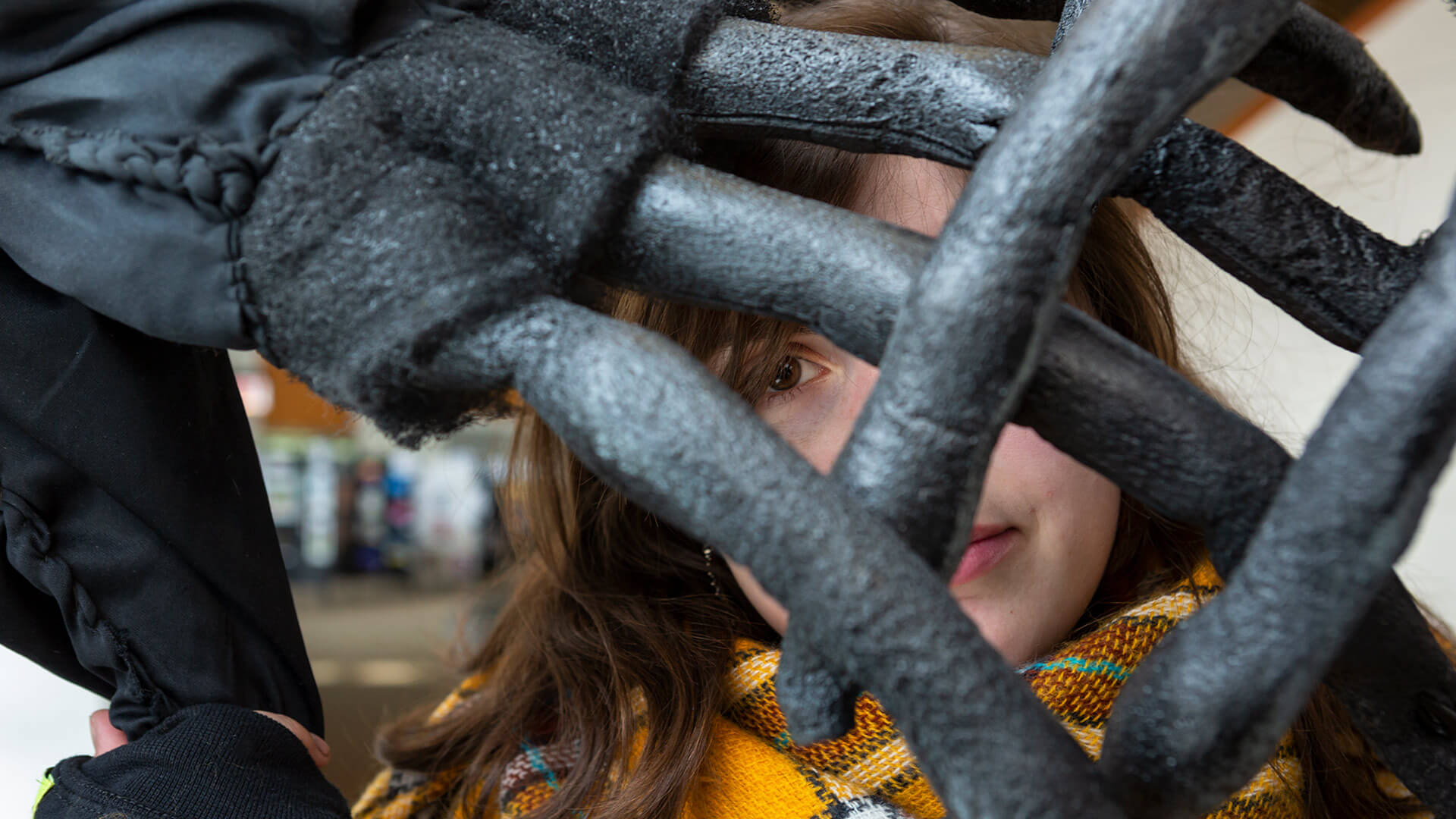
After a high school reading of “The Bell Jar”—Plath’s semi-autobiographical novel about a young woman’s experiences with mental illness—Brann became interested in the writer and eventually created “Dear Sylvia” to “say it’s okay to not be okay, but at the end of the day you do have hope. There is light in the world.”
Kristen P. Ahern MFA ’19 was inspired by the Ghost Festival celebrated in Asian countries, in which ghosts and spirits are believed to emerge from their realm. When she learned that air pollution increases dramatically during the festival, she decided to create something environmentally sustainable inspired by the celebration, using recycled and found materials to build her four puppets.
“One of the things I’ve always been interested in as a designer is the waste that is created as we design,” said Ahern. “We put up plays or musicals or operas for two weeks and then everything gets thrown away or put into storage until it gets thrown away 20 years later.”
Using shipping boxes, bubble wrap, scrap fabric, elements of shelving units and more, Ahern created puppets inspired by fire, water, air and earth. (No puppets will be harmed during the fire component, she promises.)
Also presenting their projects will be Christopher Brusberg MFA ’19 and Lauren Duffy, whose work focuses on the grieving process, and MFA dance candidate Stacey Carlson ’19, whose piece explores Jungian theories of personality.
The showcase isn’t the only puppet-centric offering in the School of Theatre, Dance, and Performance Studies this semester; the course “Puppet Cinema: When Film and Puppetry Meet on Stage” gives students the chance to learn about the craft from puppeteers.
Puppetry is “a part of both dance’s history and theater’s history,” said Maura Keefe, interim director of the School of Theatre, Dance, and Performance Studies. “It’s a great part of Maryland’s history as well because of Jim Henson’s legacy.”
In January 2005, The Jane Henson Foundation and The Jim Henson Legacy generously donated videos and funding to support the creation of the Jim Henson video collection at the University of Maryland (previously known as The Jim Henson Works).
This collection makes available to UMD’s community of students, scholars, and visitors 68 digital videos spanning 35 years of Henson’s groundbreaking work in television and film. These full-length videos are available for viewing at public computer stations within the Michelle Smith Performing Arts Library, McKeldin Library, and Hornbake Library.
Researchers can also contact SCPA to arrange for time-limited remote access to the videos. The University provides a wide range of research opportunities into Henson's work and puppetry in the performing arts. It also hosts exhibits and websites, develops interactive interpretive content, and takes part in celebrations of Jim Henson's life.
From the very beginning, Jim Henson and his Muppets combined play and learning through singing, dancing, and acting, all with the timeless use of puppets as performance objects. It is ideal this collection resides within the Michelle Smith Performing Arts Library at the Clarice Smith Performing Arts Center, as the Center is a leading academic institution training future performance professionals and scholars.
Each resident department of the Center will find its own use for such a collection: the Theatre Department now hosts a Jim Henson Artist in Residence and offers courses in puppetry, the School of Music offers various classes in popular music and culture, and the Dance Department is known for its cutting edge performance program where multidisciplinary projects are encouraged.
Yet, elsewhere on campus, this collection will also be of use to UMD’s American Studies program where studies in popular culture and humor are offered. Really, the possibilities are endless
The Edward L. Longley Collection on Jim Henson covers the period from 1957 to 2003; the bulk of the materials date from 1979 to 1997. The collection includes a brief biography and lesson plan on puppetry, but the majority consists of newspaper clippings and various periodicals featuring narratives on Jim Henson's career. Also included are a few photographs of Jim Henson, his artwork, and two paper-mache heads, one male and one female.
Kermit the Frog Comes Home
Kermit the Frog comes home to UMD in guest lecture

Statue of Kermit the Frog and Jim Henson outside of Stamp Student Union. (Mateo Pacheco/The Diamondback)
September 30th, 2024
by Cameron Lee
Crowds flocked to The Clarice Smith Performing Arts Center Friday for a lecture from “the world’s most famous amphibian” — Kermit the Frog.
Muppet performer Matt Vogel joined the talking frog during the discussion alongside the evening’s host — arts and humanities college dean Stephanie Shonekan.
Jim Henson, creator of The Muppets and Kermit’s main performer for decades, graduated from this university in 1960. On campus, he and the iconic frog are memorialized in a bronze statue depicting the two sitting on a red granite bench outside Stamp Student Union.”
The event, part of this year’s arts and humanities dean’s lecture series, also included a Q&A with Kermit and performances of famous muppet tunes by members of multiple musical groups at this university.
“I grew up with The Muppet Show and Kermit, so this is just really exciting ” junior history major Melody Freed said.
After performances of “The Muppet Show Tonight,” “Mahna Mahna” and a rendition of “Happy Feet” by Kermit himself, the lecture began with Vogel, Kermit’s main performer since 2017. In it, he discussed his background as a muppet performer and his feelings on the craft.
Vogel’s reverence for Henson was evident as he spoke, as was his passion for the art of puppeteering and the joy it brings others.
“I really liked how personal everything felt, all the questions,” sophomore music education major Marli Banner said. “He was speaking from his heart, even through Kermit.”
Kermit’s arrival at Friday’s event was met with vigorous applause. The muppet spread a message of love and acceptance, telling the audience that it’s okay if they’re different or have different ideas, as long as they dream big and follow their passions.
The frog urged attendees to look to places that remind them to be “perfectly one of a kind,” such as a song, book or community, he said.
The most memorable moment of the night was the show’s closing, which featured a Kermit-led singalong to “Rainbow Connection.”
Some people in the audience were moved to tears. Others knew all the words by heart.
Gracie Morgan, a junior clarinet performance major, said she got tickets to the event as soon as she heard Kermit was coming to this university.
“It was cool to see all the audience members, young to very old people, just connecting with Kermit,”she said.
In UMD Visit, Kermit Makes a Rainbow Connection With Terps
Famed Frog (and his Performer) Talk With ARHU Dean About Jim Henson ’60, Miss Piggy and Life Lessons From the Muppets
September 30, 2024
By Sala Levin ’10

Kermit the Frog led a sold-out crowd in a singalong of “Rainbow Connection” on Friday night, when the Muppet appeared at The Clarice as part of the College of Arts and Humanities’ Dean’s Lecture Series.
Photos by Stephanie S. Cordle
It might not be easy being green, but for one lively evening at the University of Maryland, Kermit the Frog sure made it look fun.
On Friday, the loveable lead Muppet took the stage at the Clarice Smith Performing Arts Center’s Dekelboum Concert Hall to sing, answer questions and, once or twice, throw his hands up and shriek when his emotions got the best of him. As part of the College of Arts and Humanities’ Dean’s Lecture Series, Kermit—along with his puppeteer, Matt Vogel, who spoke about his own journey with the Muppets—chatted (below) with Dean Stephanie Shonekan about the Muppets’ ethos of inclusivity and individuality, what he learned from Jim Henson ’60 and his fraught relationship with Miss Piggy.

“What we’ve done really hasn’t changed much,” said Kermit. “Fozzie is still trying to find the perfect punchline, Gonzo still goes round and round about how many chickens he can stuff into a wheelbarrow and run the New York City marathon at the same time, Miss Piggy will always expect a big number, even if we’re not doing a show, and I’ll always be seeing the best in my friends and standing by them.”
The sold-out event honored the long history between UMD and the Muppets’ creator. Henson and his wife and collaborator Jane Henson ’55 graduated from the university, and Jim invented Kermit while a home economics major, building the frog out of one of his mother’s coats and a ping-pong ball cut in half.
The all-ages crowd was brought to its feet as School of Music faculty members and students performed “The Muppet Show” theme and “Mahna Mahna.” Kermit teamed up with student tap dancers for a take on “Happy Feet” and partnered with banjo player Lucas Ross (below) for his ode to self-acceptance, “Bein’ Green.” At the end of the night, the audience sang along with Kermit on his signature song, “Rainbow Connection,” accompanied by Arts for All Director Craig Kier on piano.
Here are five froggy takeaways from Vogel and Kermit’s conversation with Shonekan and a Q&A with audience members.

Kermit takes after his human creator. “As I understand it, Kermit is a lot like Jim,” said Vogel: calm, soft-spoken, hardworking and optimistic. There are even aural similarities between Henson and Kermit. “If you heard Jim Henson speaking as Jim Henson, he sounded just like Kermit,” said Vogel, who’s been voicing the character since 2017. (Vogel also plays Big Bird, Count von Count, Lew Zealand and Gonzo’s chicken sweetie, Camilla.)
There’s no bad blood between Kermit and Miss Piggy. Call Page Six! Kermit made a statement on his notoriously tempestuous relationship with his pink porcine co-star in response to an audience member’s question. “Miss Piggy’s doing great,” Kermit said. “We’re really good friends. We talk and text all the time.” Admittedly, it’s not all sunshine and lily pads. “She texted me before the show wondering where I was,” Kermit said. “I didn’t want to tell her because I knew she’d come find the place and take over.
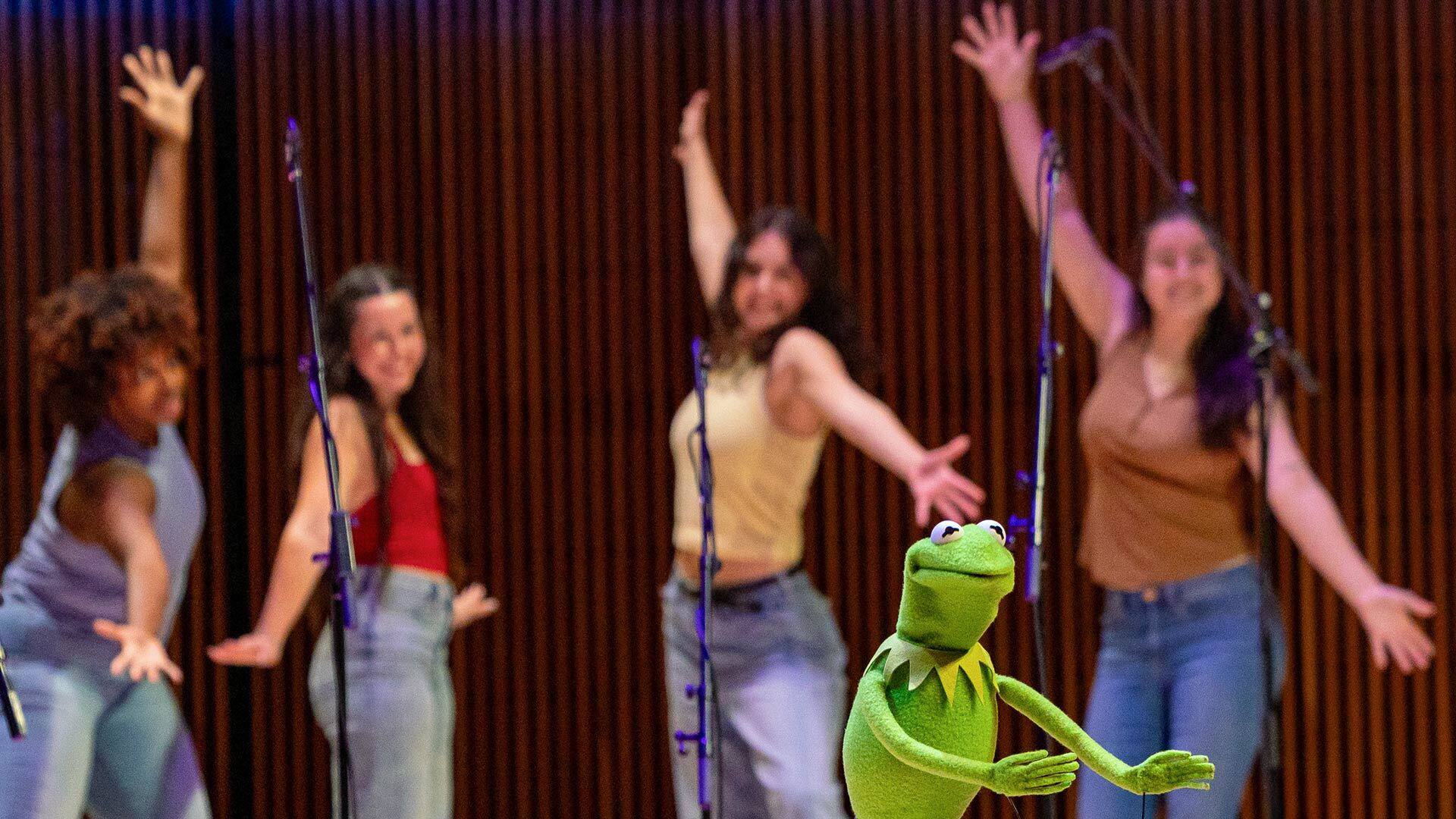 Kermit performs with School of Theatre, Dance, and Performance Studies dance majors and the School of Music Graduate Jazz Quartet.
Kermit performs with School of Theatre, Dance, and Performance Studies dance majors and the School of Music Graduate Jazz Quartet.
Kermit might have invented a new flavor for the Maryland Dairy. Vanilla, cookies and cream, even the Dairy’s own Kermit’s Kiss aren’t to his ice cream tastes. When an audience member asked his favorite flavor, Kermit had no trouble answering. “Dragonfly ripple,” he said with a well, duh shrug. “Isn’t it everybody’s?”
UMD’s beloved turtles are just fine by Kermit. In fact, he once had a turtle roommate named Phil, he said, though it didn’t work out. “He didn’t like my banjo-playing, and he just kept snapping at me.” Later, UMD President Darryll J. Pines asked Kermit to say “I’m Kermit the Frog, and I have Maryland pride.” Kermit happily obliged, then asked, “Is it contagious?”
Kermit lives by the words Jim Henson wrote in a letter to his kids at the end of his life. “He said, ‘Please watch out for each other, and love and forgive everybody. It’s a good life. Enjoy it,’” said Kermit. “I try to remind myself of that every day.”
Kermit the Frog to Deliver 2025 Commencement Address
Alum Jim Henson’s Beloved Muppet Will Address Graduates at Campus Ceremony
March 26, 2025
The University of Maryland announced Wednesday that Kermit the Frog will deliver the university’s 2025 commencement address on May 21. The beloved Muppet will address Summer 2024, Winter 2024 and Spring 2025 graduates, family and friends during the ceremony at SECU Stadium.
After a sold-out visit to campus in Fall 2024 as part of the College of Arts and Humanities Dean’s Lecture Series, Kermit will return to the university from the Muppets Studio, part of the Magic of Disney, to share an inspiring message with this year’s graduates.
Kermit the Frog’s appearance honors the long history between UMD and Muppets creator Jim Henson, who graduated from UMD in 1960. Henson, a home economics major, invented Kermit by building the original frog puppet out of one of his mother’s coats and a ping-pong ball cut in half.
“I am thrilled that our graduates and their families will experience the optimism and insight of the world-renowned Kermit the Frog at such a meaningful time in their lives,” said UMD President Darryll J. Pines. “Our pride in Jim Henson knows no bounds, and it is an honor to welcome Kermit the Frog to our campus, 65 years after Mr. Henson graduated from the University of Maryland. I sincerely thank the Muppets Studio, Disney and their creative teams for making this possible.”
“Nothing could make these feet happier than to speak at the University of Maryland. I just know the class of 2025 is going to leap into the world and make it a better place, so if a few encouraging words from a frog can help, then I’ll be there!” said Kermit The Frog.
More details about the campuswide ceremony are available at commencement.umd.edu.
7 Fun Facts for Kermit’s 70th Birthday
From Creator Jim Henson’s UMD Roots to a Deep Dive on ‘Bein’ Green,’ Leap Your Way to Froggy Expertise
May 9, 2025
Kermit the Frog likes to say he was born in a swamp with thousands of tadpole siblings, but Terps know better: The affable amphibian was actually created at the University of Maryland.

Seventy years ago, Jim Henson ’60 cut up his mother’s faded, felt turquoise coat and glued two halves of table tennis balls on it to create the first version of Kermit while he was a home economics student, kicking off his career in puppetry and television.
Kermit has hardly aged a bit, and he’s coming home (again!) on May 21 to speak at the university’s main Commencement ceremony—already nicknamed “Kermencement.”
To celebrate his birthday, make like a frog and slurp down some fun facts:
There would be no Henson or Kermit without the University of Maryland: His father, Paul Henson M.S. ’30, was studying genetics and plant biology in College Park when he met and eventually married Elizabeth “Betty” Brown, secretary to the dean of what was then the College of Agriculture, and the family eventually settled in University Park. Their son went on to meet future wife Jane Nebel ’55 in a new UMD puppetry class, with whom he created his first television show, “Sam and Friends.” (It aired on NBC4 in Washington from 1955-61.)
This isn’t the first time Kermit’s delivered the UMD Commencement address: In 1996, Kermit teamed up with fellow Muppet Elmo to address Terp grads alongside science journalist Michael Guillen. The unlikely trio shared “a commitment to education, a passion for the environment, and a childlike curiosity they hope to inspire in others,” according to the December 1996 Commencement booklet.
The Henson and Kermit statue in front of the Stamp Student Union was a gift from alums: It was dedicated in 2003 as a gift from the Classes of 1994, 1998 and 1999. The popular bench depicts the two in conversation—with just enough space for an extra person to join their chat.
A Kermit-esque puppet sold coffee: While a UMD student majoring in home economics, Henson produced 179 commercials for Wilkins Coffee in Washington, D.C. from 1957-61. They featured cheerful puppet Wilkins, who loved the caffeinated beverages, and grumpy Wontkins, who became so popular that the company offered vinyl versions of the hand puppets through the mail.
“Bein’ Green” is an ode to self-acceptance: In the latest episode of “Cover Story,” a podcast hosted by College of Arts and Humanities Dean Stephanie Shonekan, she explores the song’s themes. She interviews Henson’s daughter, Cheryl, as well as the son of Joe Raposo, who composed it, and explores how famous artists like Ray Charles and Frank Sinatra covered it over the years.
The 2024 Disney+ film “Jim Henson: Idea Man,” was produced by an alumna: Nominated for eight Emmys, the documentary by Sara Bernstein ’95, president of Imagine Documentaries and graduate of the Philip Merrill College of Journalism, delves into the Henson family archives and offers a deeply personal look at how Henson and his wife launched the Muppet empire.
A life-size Kermit once took to the UMD football field: To honor Henson just months after his death in 1990, his wife Jane served as Homecoming grand marshal and was joined by Kermit, paramour Miss Piggy and kid favorite Cookie Monster as they sang and danced.
Grab some Muppet-themed UMD gear from the University Bookstore or other retailers—and be on the lookout for new offerings around Commencement. And check out the Jim Henson video collection at the Michelle Smith Performing Arts Library. Donated to UMD in 2005, these 68 videos span 35 years of his work including “A Muppet Family Christmas,” episodes of “The Muppet Show” and “Fraggle Rock,” and “The Jim Henson Hour.”
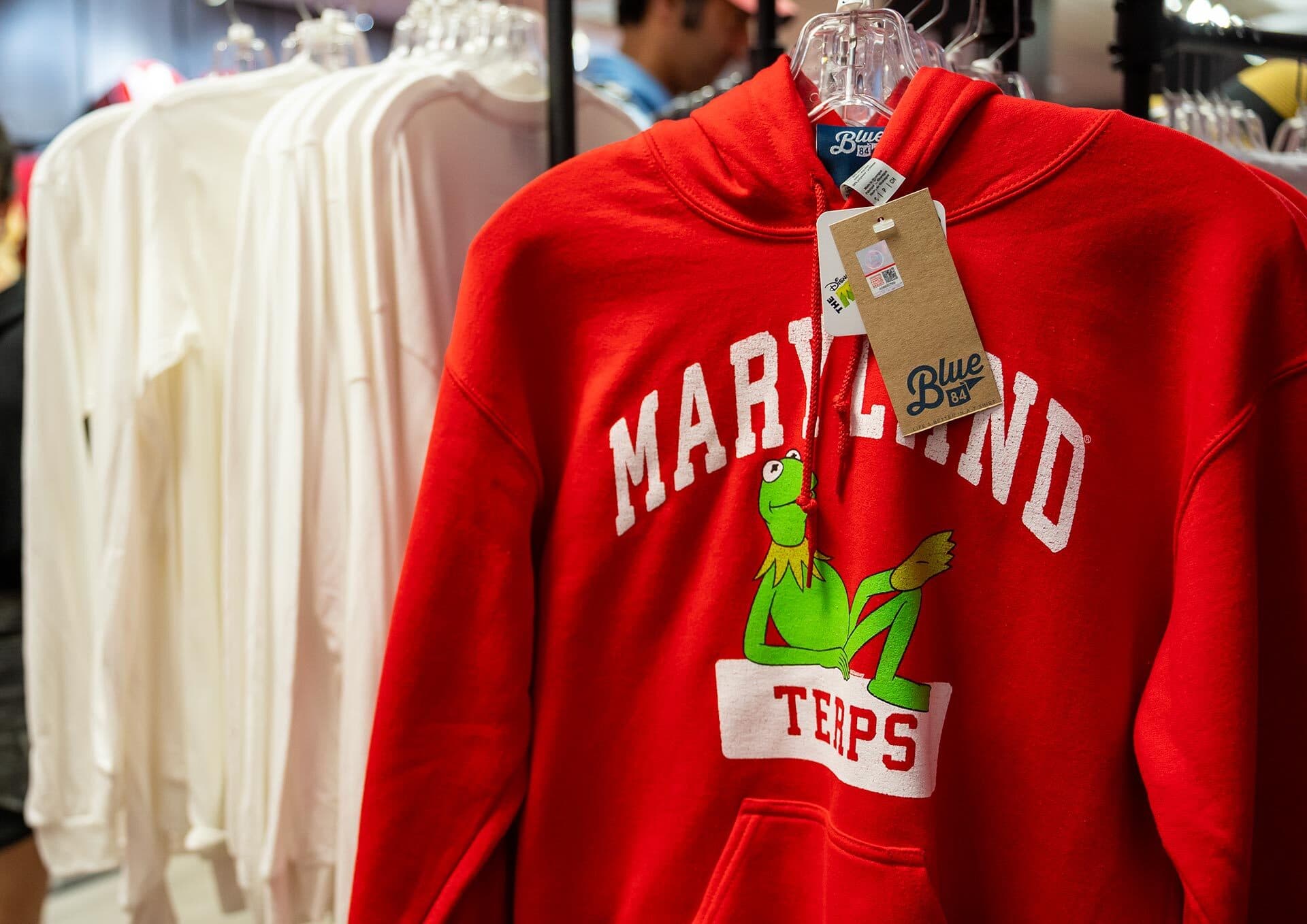
Kermit the Frog Challenges Graduates to ‘Write Your Own Ending’
At 2025 Commencement, Famed Amphibian Implores Students to Make, Keep Connections
May 23, 2025
By John Tucker
Dressed in full (albeit tiny) academic regalia, Kermit the Frog encouraged University of Maryland graduates to “leap together” while embracing life’s “big, messy, delightful ensemble piece” during Commencement on Thursday.
Kermit, the cuddly creation of Jim Henson ’60, sent the crowd into uproarious applause throughout his “Kermencement” address, interspersed with trademark swampy humor.
“I can tell you’ve all worked your tails off,” he said. “And as a former tadpole, believe me, losing your tail is a pretty big deal!”
Chilly temperatures and an intermittent drizzle on SECU Stadium didn’t dampen the mood at the ceremony, which honored nearly 13,500 graduates from August and December 2024 and May 2025: an estimated 9,265 Terps who earned bachelor’s degrees, 3,254 who completed master’s degrees and 924 with doctorates.
UMD President Darryll J. Pines called on graduates to remember how their UMD experience changed them. “It has made you stronger,” he said. “It has made you wiser. And it has shown you how to be fearless—so now you can now go fearlessly forward."
Using a suitcase metaphor, student speaker Gregory Garin ’25 challenged his peers to embrace their pasts, including the difficult moments.
“Our suitcases are completely unique to each and every one of us, chronicling our life’s experiences, helping to tell our stories, testaments to the trials and triumphs of our journeys,” he said. But graduation, he noted, is an opportunity to collect new experiences. “What will you do with your suitcase?”
Other highlights included the bestowing of honorary degrees upon former U.S. Sen. Benjamin L. Cardin and former U.S. Rep. C.A. Dutch Ruppersberger, both of Maryland. In addition, Vainavi Gambhir ’25 was recognized as university medalist, the highest honor bestowed on a graduating UMD senior each academic year.
University System of Maryland Chancellor Jay A. Perman called on graduates to forge ahead “with grit and grace, with hope and hard work, with the powerful joy of a dream fulfilled.”
Addressing grads on video, Maryland Gov. Wes Moore told them to “take all that you have learned and pledge to use it for good. You’ll be rewarded for all your hard work and success from your time here.”
But it was Kermit, who recently celebrated his 70th birthday, who stole the show, capping his speech with a sing-along rendition of “Rainbow Connection.” Students swayed, clutched Kermit dolls and chanted his name. Earlier in the ceremony, Pines, on behalf of Moore, honored the Muppet with a citation in appreciation of outstanding service to the citizens of Maryland.
As he celebrated UMD’s newest alums, Kermit beseeched them to stay connected to their dreams, no matter how impossible they seem.
“Life's like a movie,” he said. “Write your own ending. Keep believing, keep pretending. You've all done just what you set out to do. And you’re just getting started!”
UMD’s ‘Kermencement’ Lands on Google’s Year in Search
December 09, 2025
Amid clips of Lady Gaga’s world tour, bedazzled Labubus and the shocking Luka Dončić trade, Google’s 2025 Year in Search video on Monday featured advice from the University of Maryland’s green Commencement speaker.
“Stay connected to your dreams, no matter how big, no matter how impossible they seem,” Kermit the Frog says as he’s shown addressing Terp graduates from the stage at SECU Stadium in May. “Life’s like a movie. Write your own ending.”
The moment, included as part of Google’s annual roundup of the year’s search trends, was from May’s “Kermencement” ceremony, when the beloved Muppet created by Jim Henson ’60 spoke in his tiny academic regalia to nearly 13,500 graduates.
A photo of the scene by university photographer John T. Consoli was also included in CNN’s Year in Pictures.
UMD’s Viral Leap: How ‘Kermencement’ Captured Hearts and Headlines
College Park, Md. – What began as a joyful surprise quickly became a national sensation. The University of Maryland’s 2025 commencement, featuring beloved Muppet Kermit the Frog, sparked a cultural moment dubbed “Kermencement,” earning unprecedented attention across media and social platforms while inspiring and delighting thousands of 2025 graduates and their families.
From Teasers to Standing Ovations
On March 26, UMD announced that Kermit the Frog would be its 2025 commencement speaker, driving interest and excitement from the campus community as well as major national media outlets, from Good Morning America and CBS Mornings to The Hill and USA Today. A series of teaser posts on UMD’s social media channels, culminating in a clever announcement video generated over a million impressions across platforms. The announcement hit news and radio stations with a reach of over 30 million within a week.
Unmatched Visibility
In the days surrounding UMD’s May 22 commencement ceremony, UMD’s Kermencement was featured or aired live by all of the “Big Four” major broadcasting networks (NBC, ABC, CBS and Fox)—along with PBS, CNN, MSNBC, NPR and more—reaching over 52 million viewers and listeners across nearly 4,000 broadcast mentions in a single week. Digital media coverage surpassed 31,600 articles post-ceremony, with major national outlets such as The New York Times, Associated Press, Rolling Stone, and The Guardian spotlighting Kermit's heartfelt and humorous message.
Record-Shattering Social Media
Kermencement went viral across social media, earning over 7 billion impressions on Reddit alone and an additional 2.6 billion across other platforms. Content from media outlets and independent creators alike fueled astounding engagement. ABC’s TikTok of the speech garnered more than 1.6 million views, while influencer and creator clips racked up millions more—including one newly-minted alum’s tearful commencement experience with 818,400 and a viral “Rainbow Connection” moment with over 2.2 million.
The university’s own channels smashed engagement records, delivering more than 4 million impressions and 199,830 engagements. Footage of the ceremony became the most-viewed Instagram story in UMD history with 14,000 views, and a single photo of Kermit addressing the crowd topped all university posts with over 54,500 likes.
A Message That Resonated Worldwide
Following the ceremony, media attention continued to build. International outlets like the BBC, AFP, Daily Mail, and Australian Associated Press covered the address, while national headlines lauded Kermit's “Leap together” message and celebration of creativity, kindness and connection. The moment even drew satirical praise from The Onion and inspired commentary in outlets as varied as Salon, Inside Higher Ed, and CNBC.
A Cultural Moment to Remember
Kermit the Frog’s commencement appearance marked the storied amphibian’s second trip to campus during the 2024-25 academic year. In September 2024, he appeared at The Clarice in a sold-out engagement as part of UMD’s Arts for All program. Both Kermit’s appearance at The Clarice and as 2025 commencement speaker were made possible through close collaboration with The Muppet Studio and Disney.
Kermencement was more than a ceremony—it was a moment that captured the spirit of the Class of 2025 and celebrated UMD’s legacy with joy, humor and heart. That legacy includes— of course—Jim Henson, who while a UMD student created the puppet who would become Kermit the Frog from his mother’s coat and two halves of a ping pong ball. As his greatest creation and the world’s most famous amphibian says, “Keep believing. Keep pretending.”

